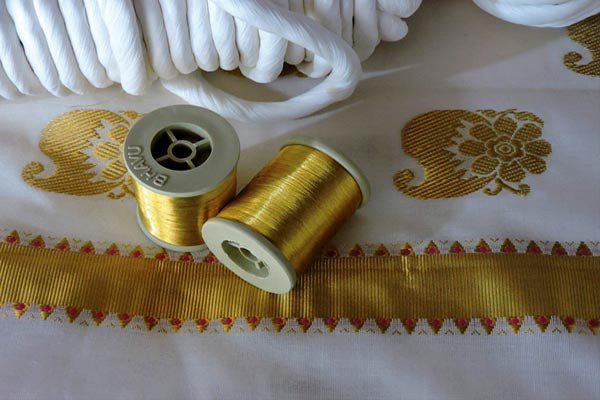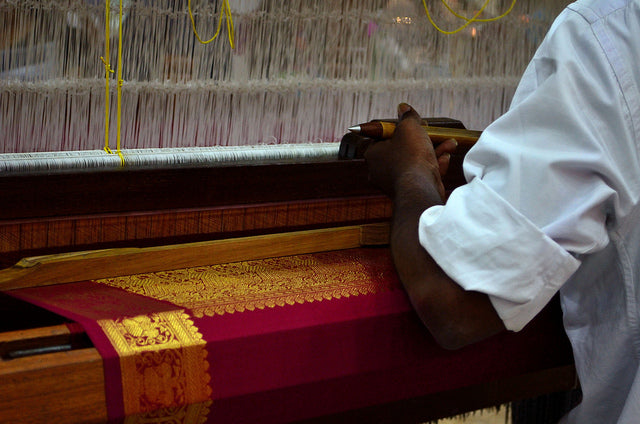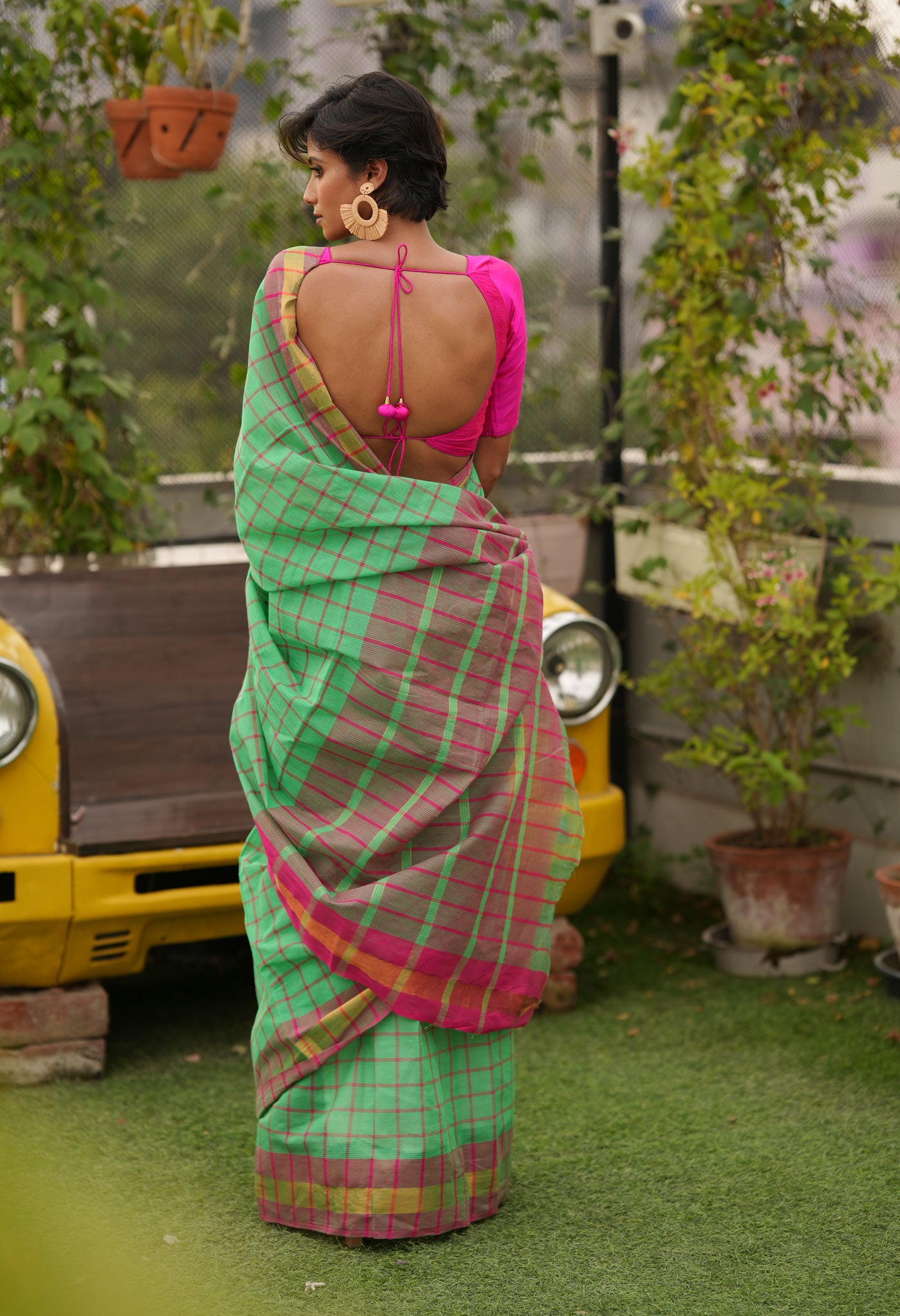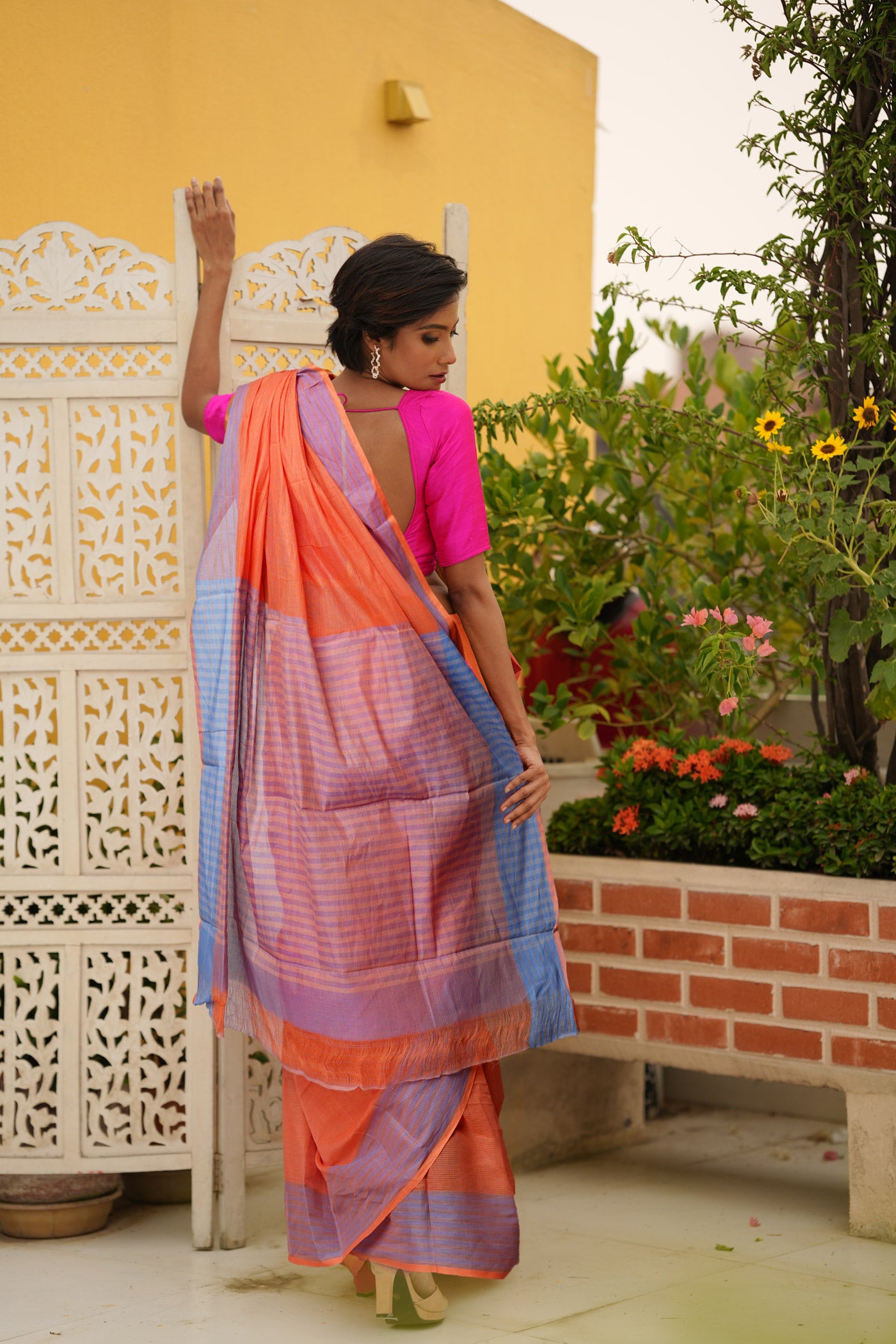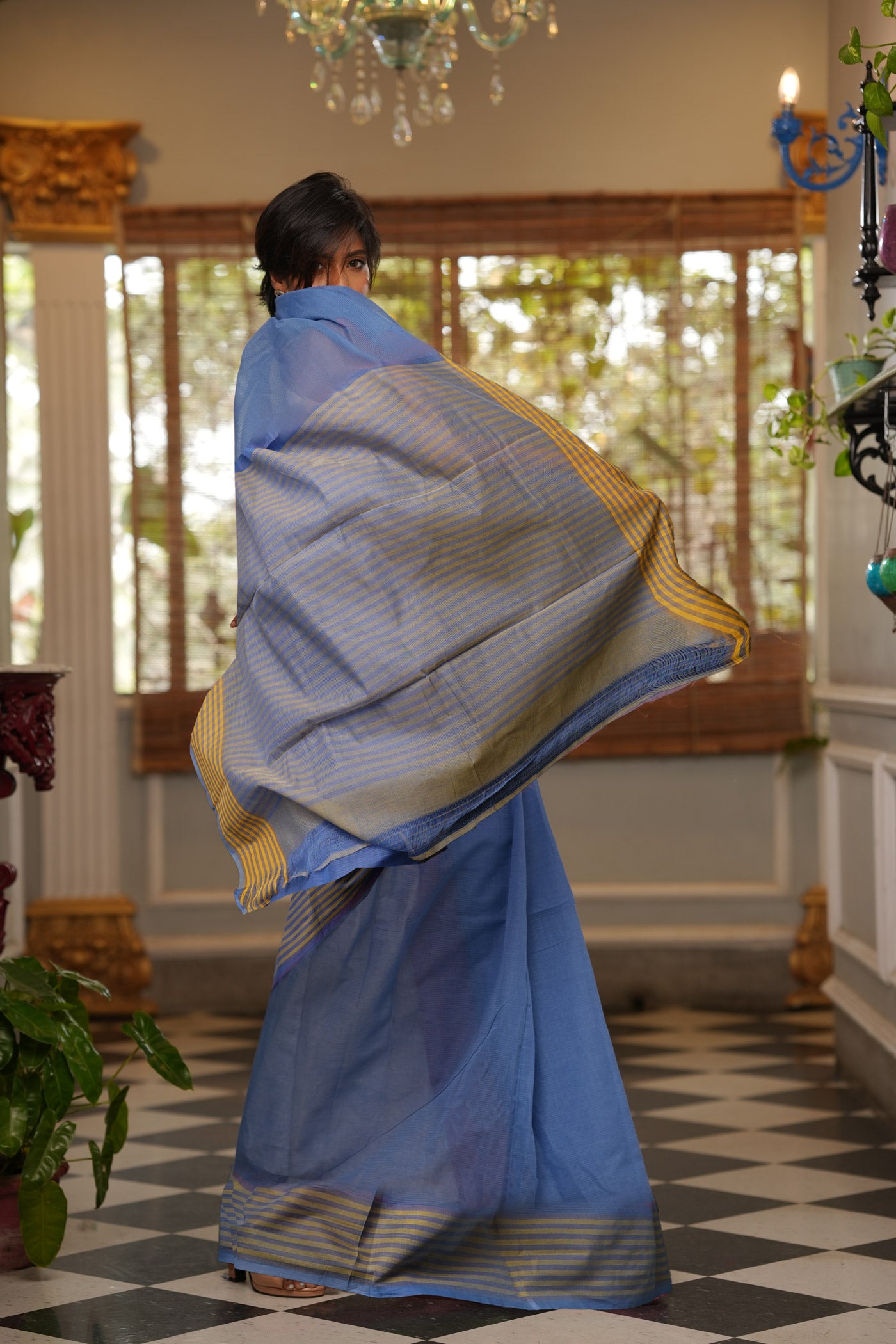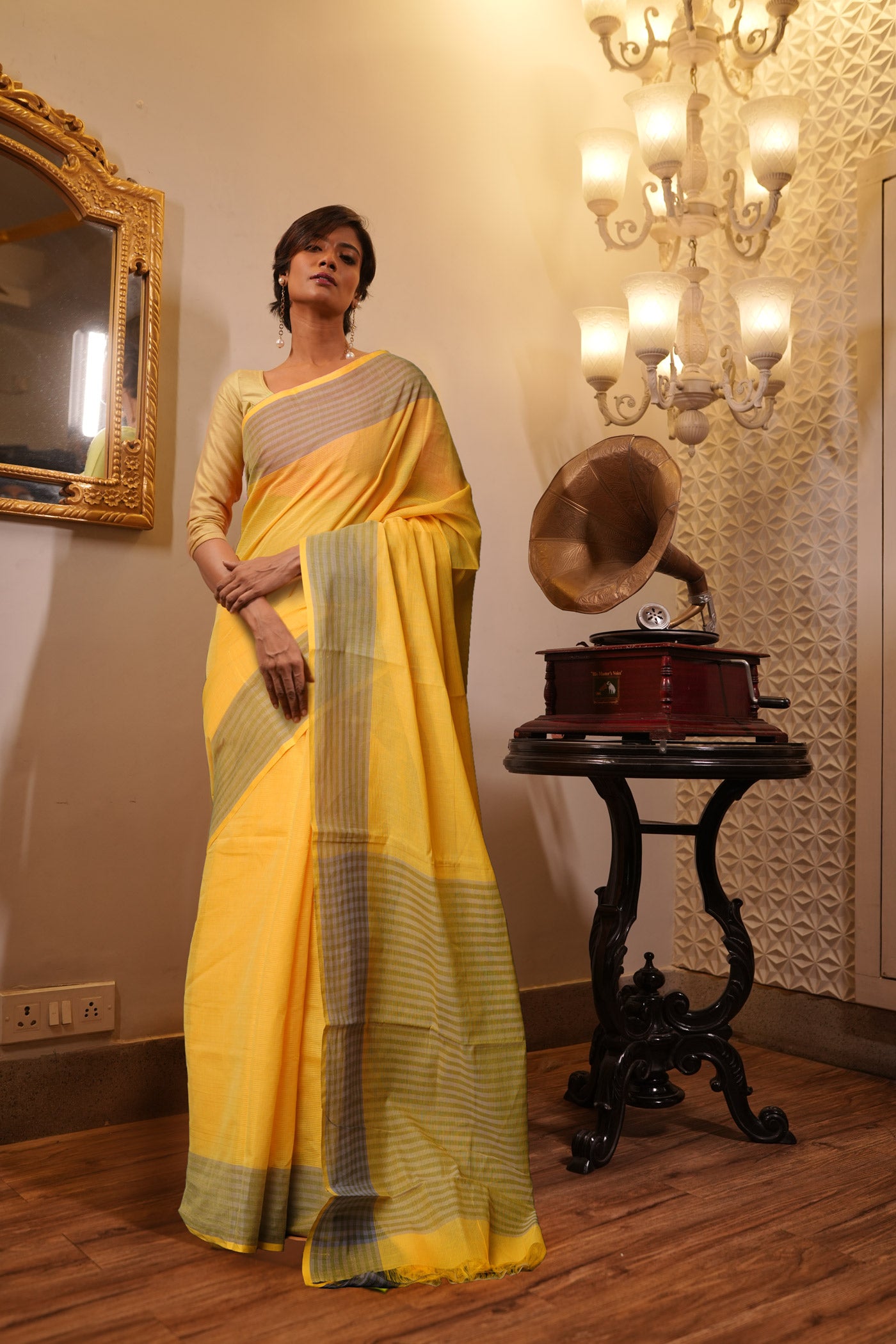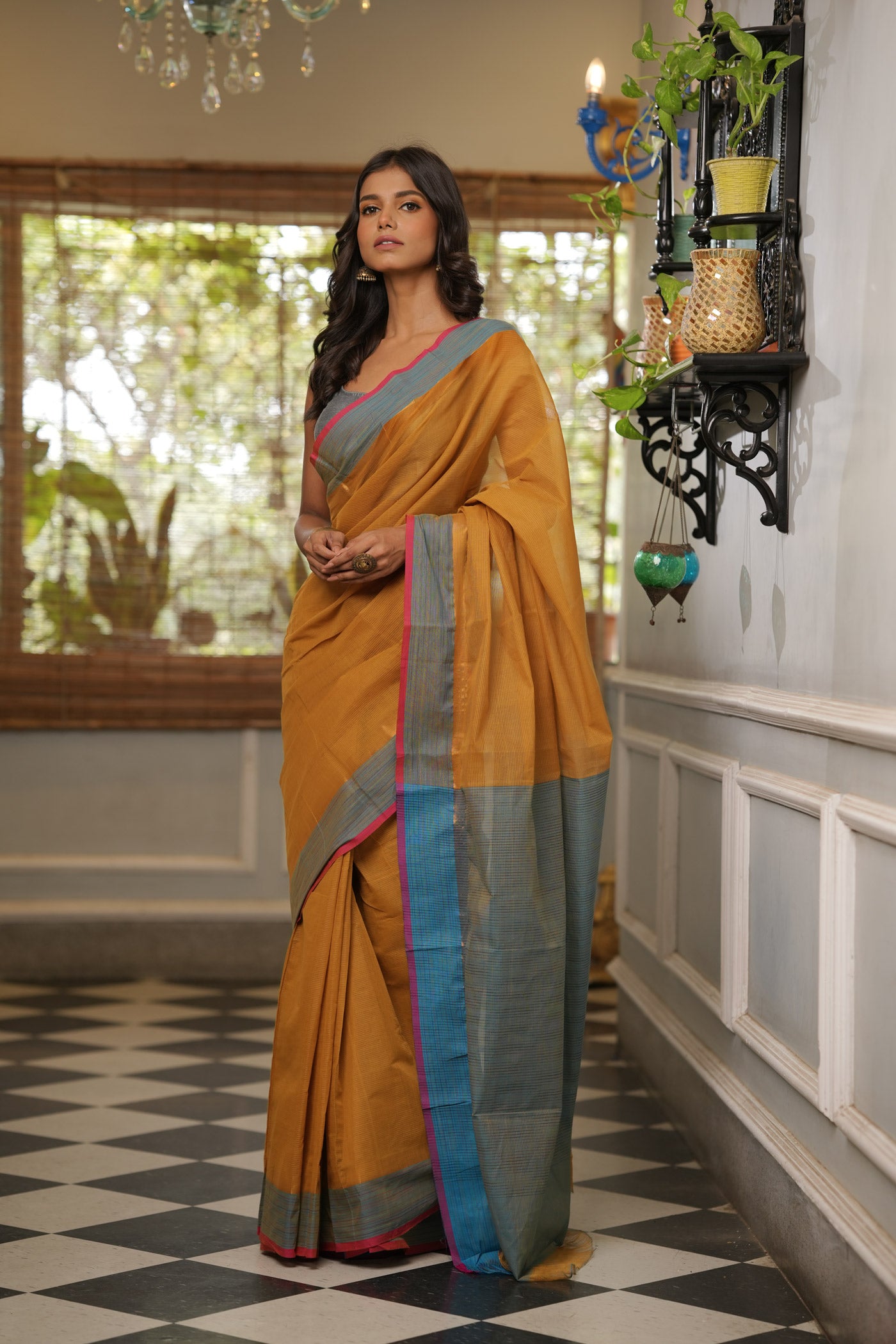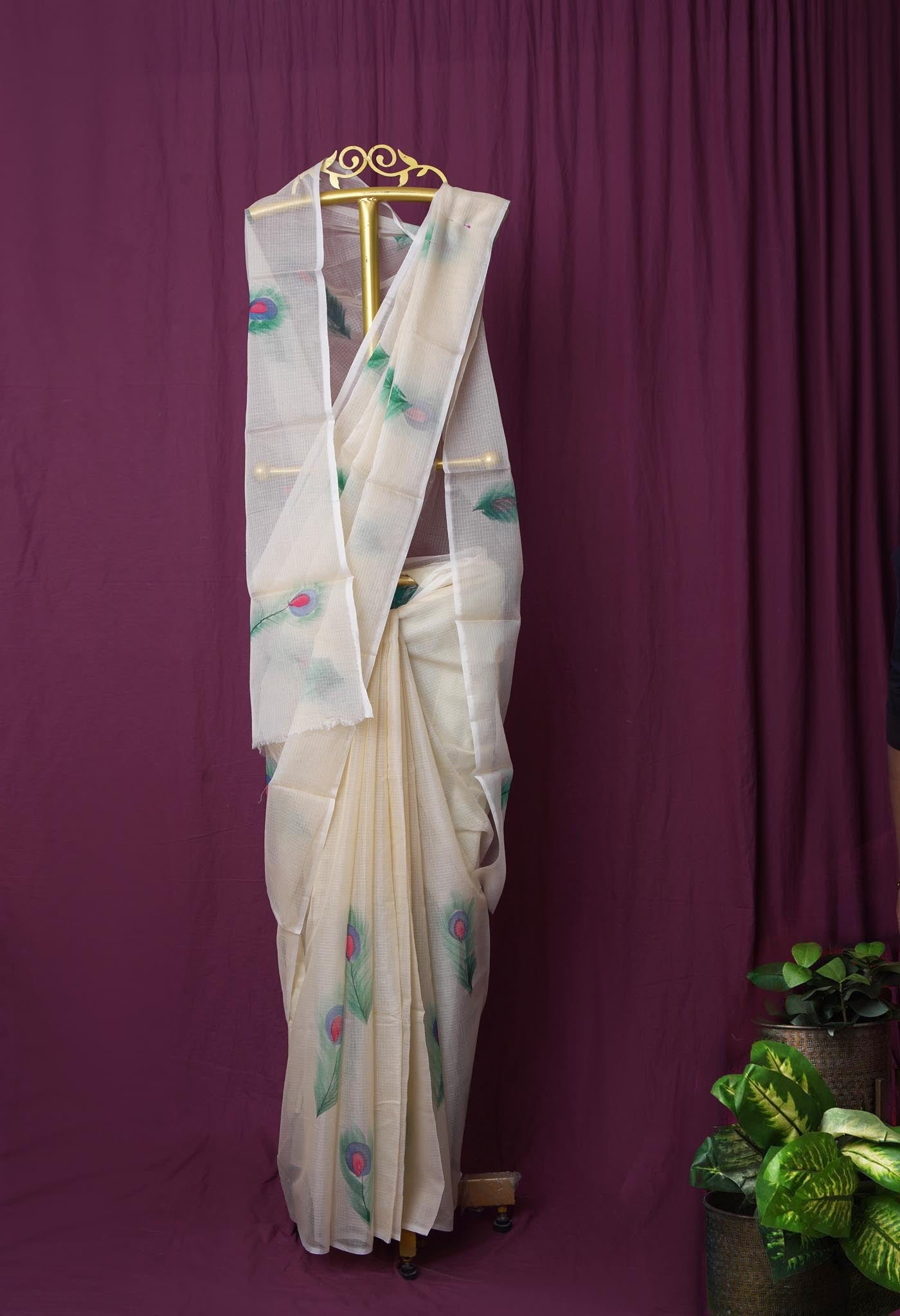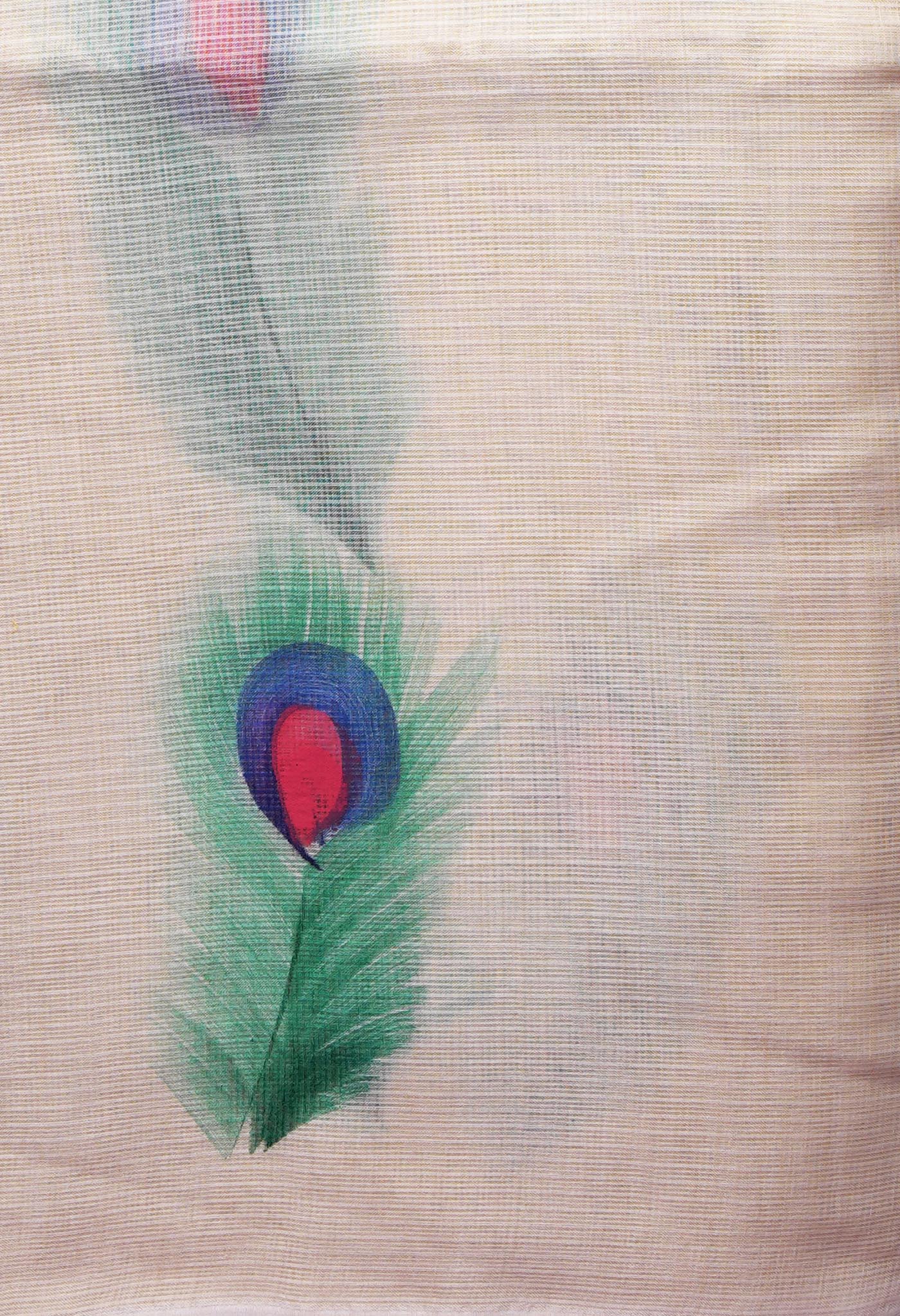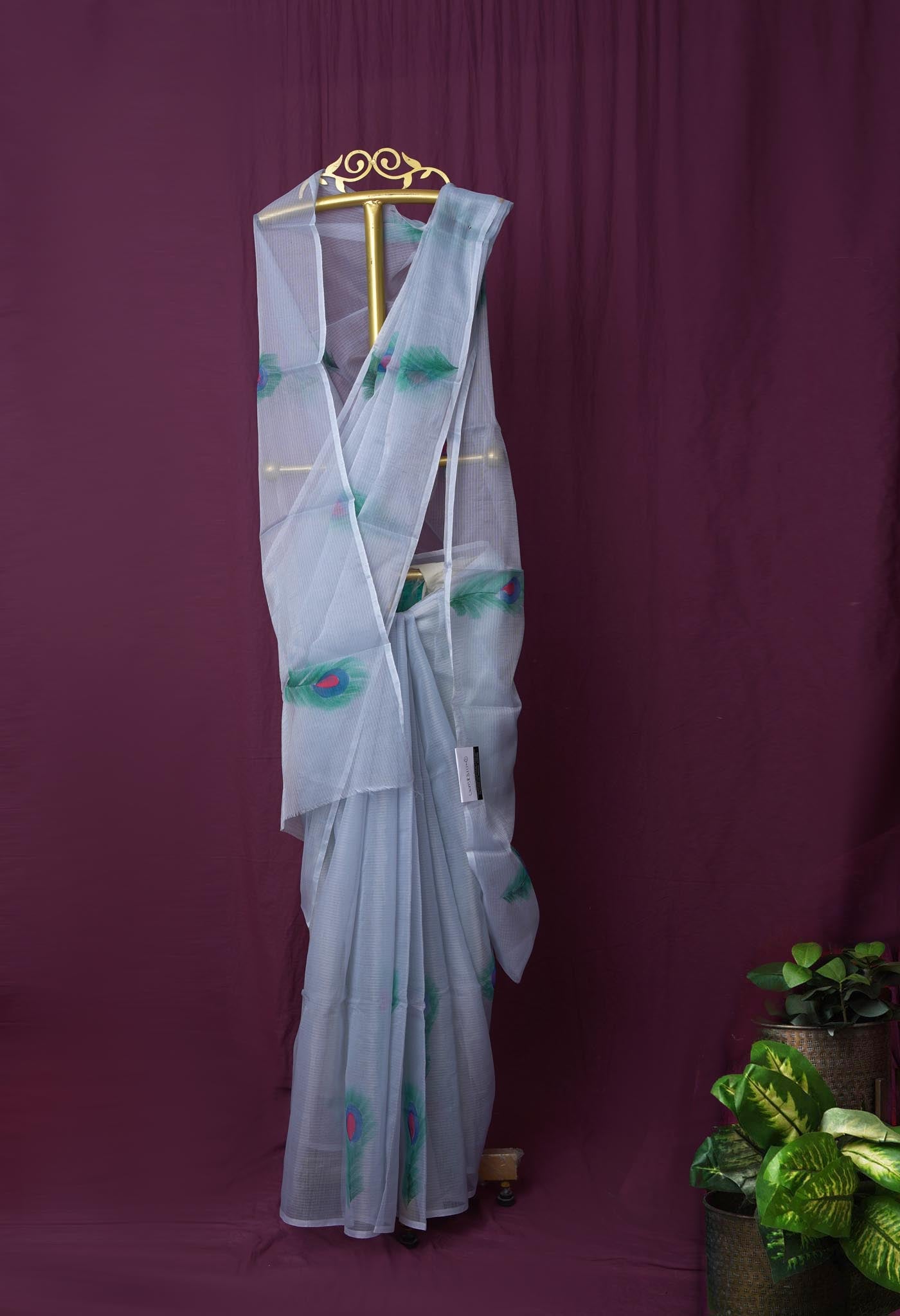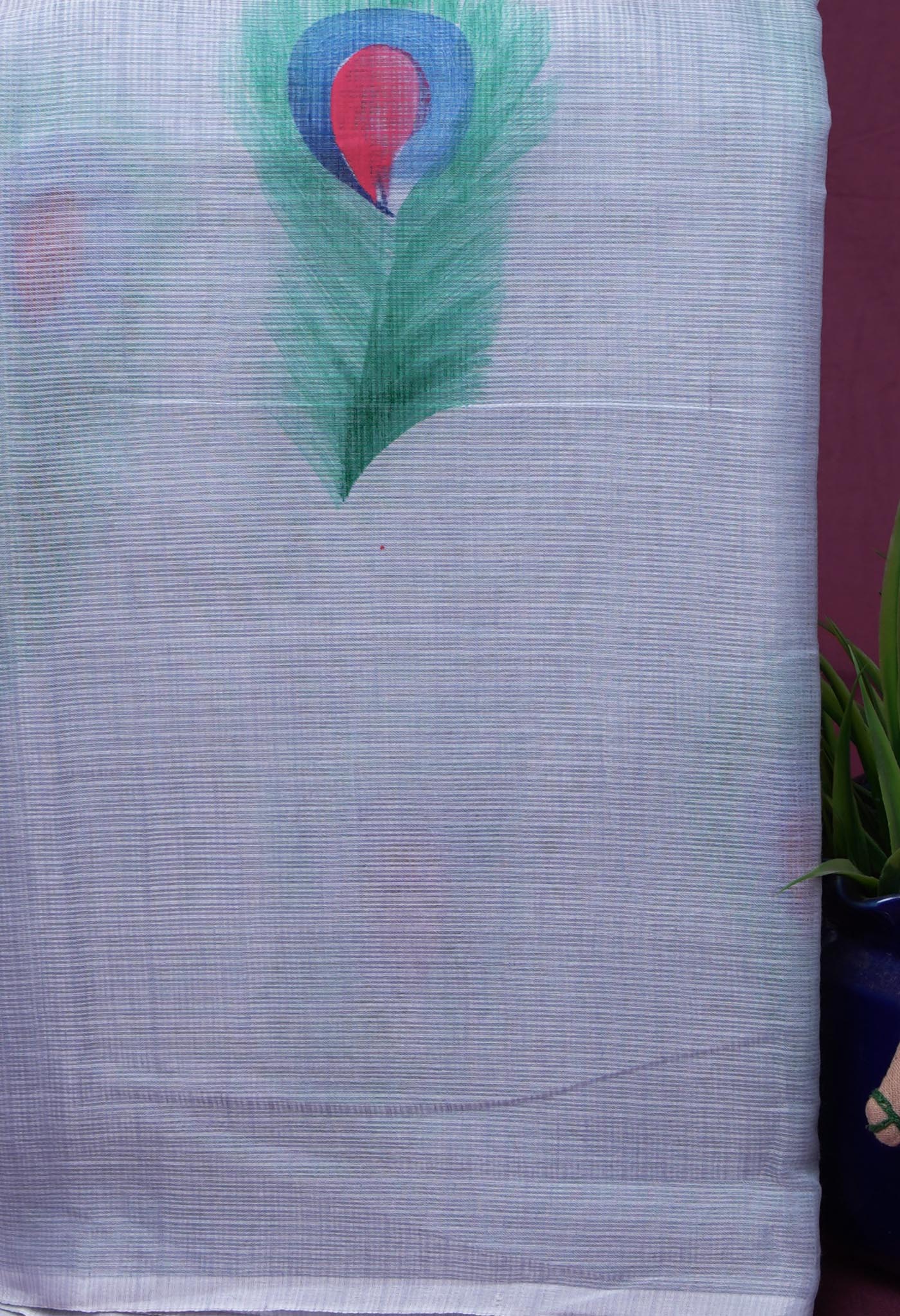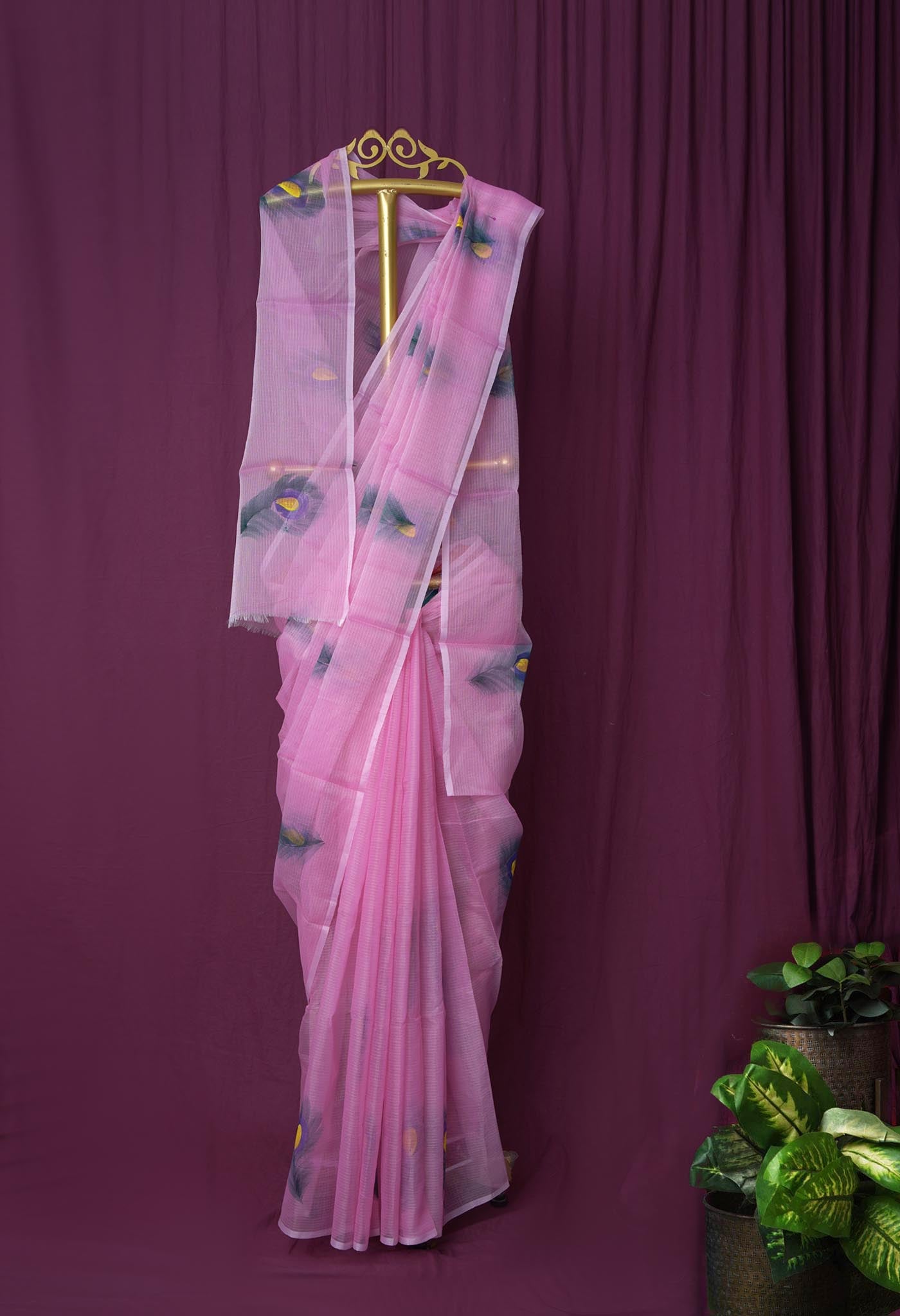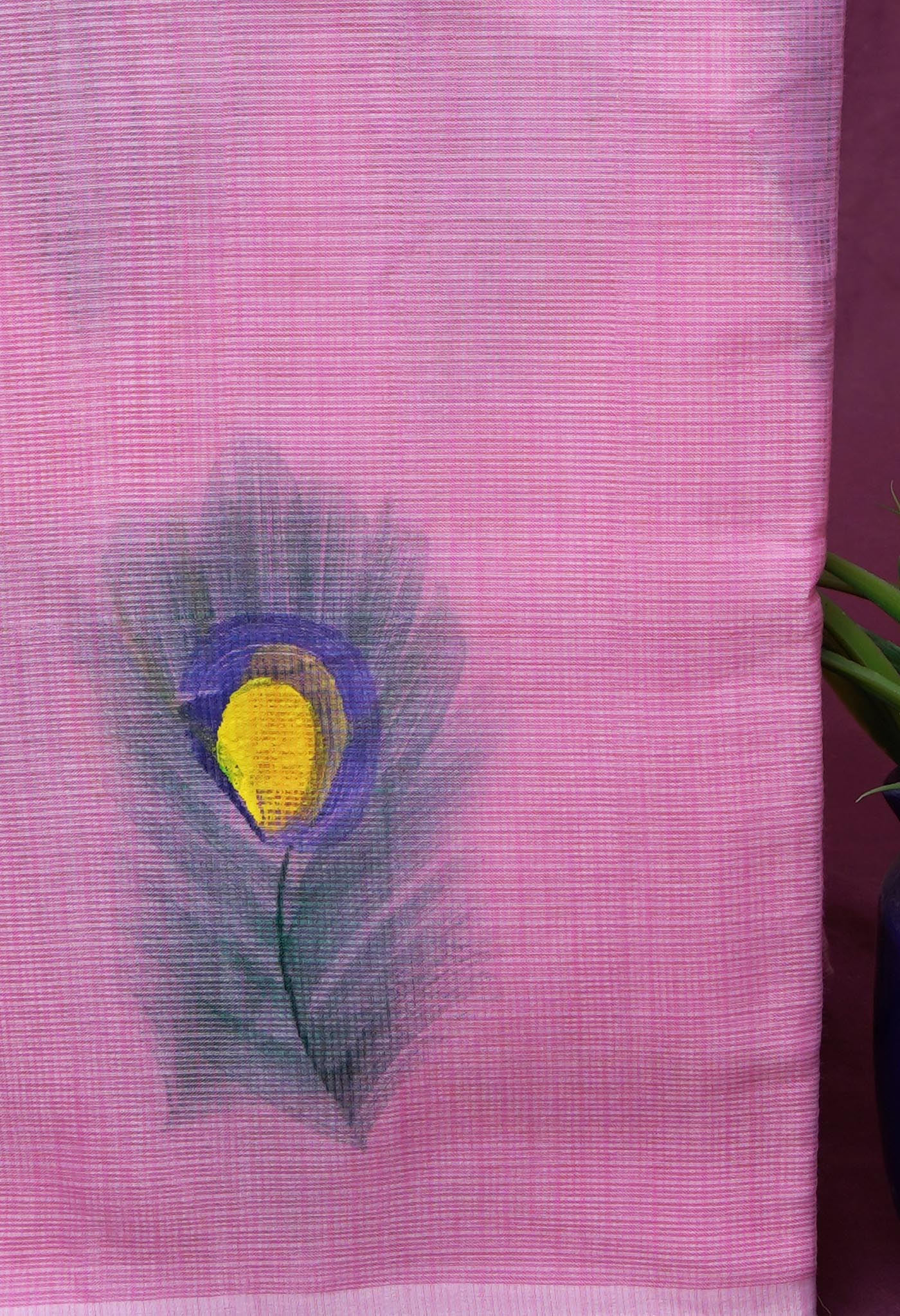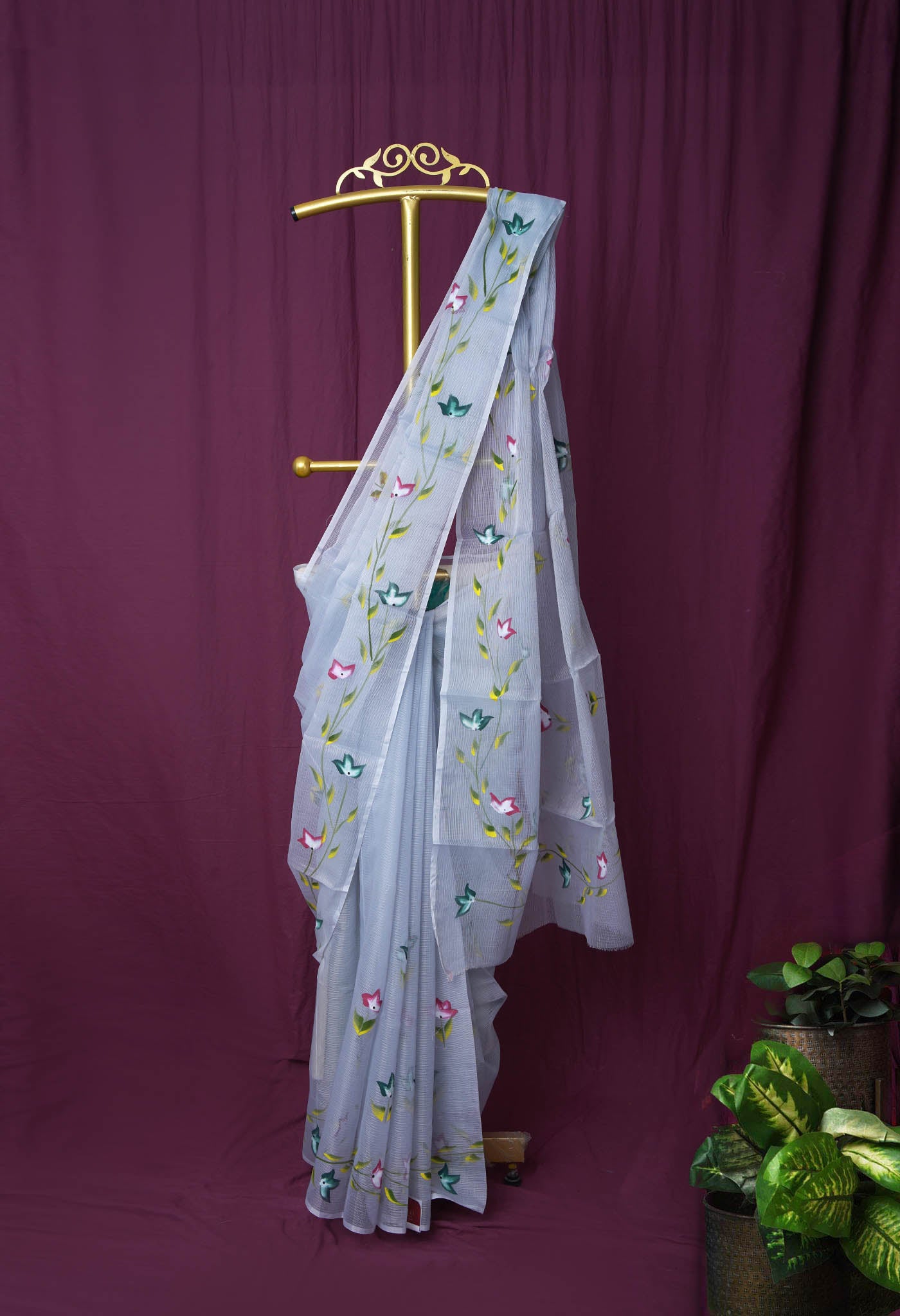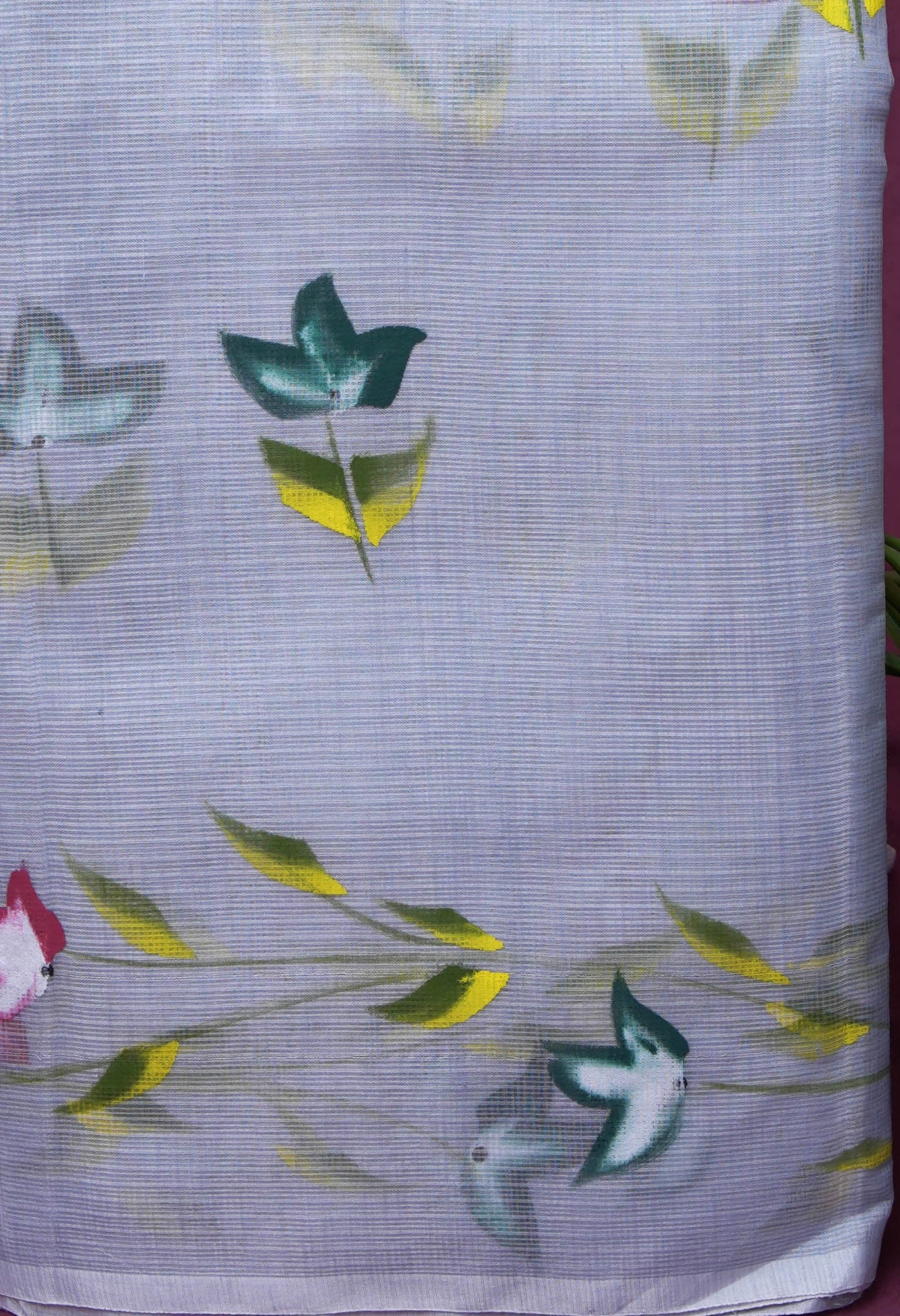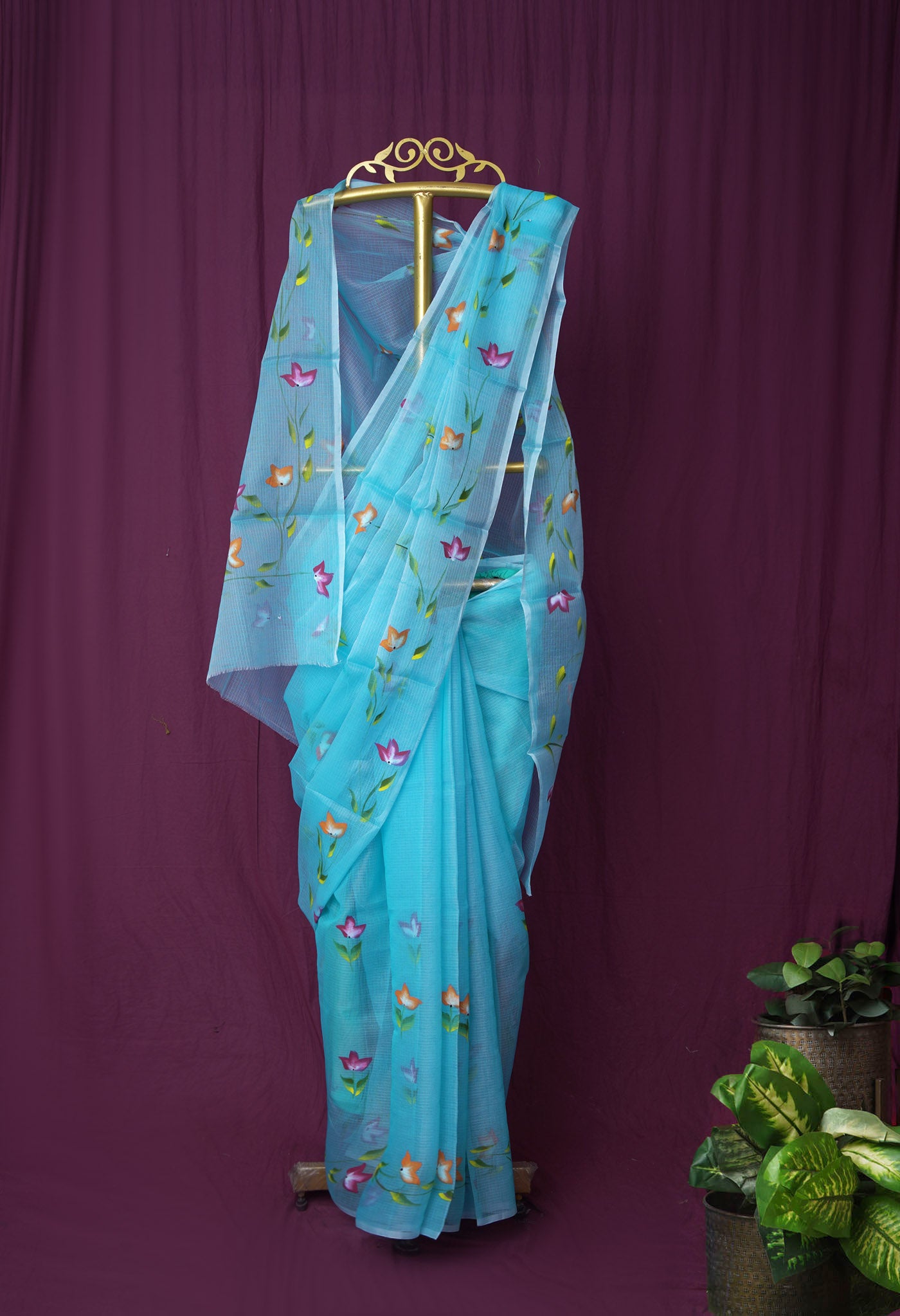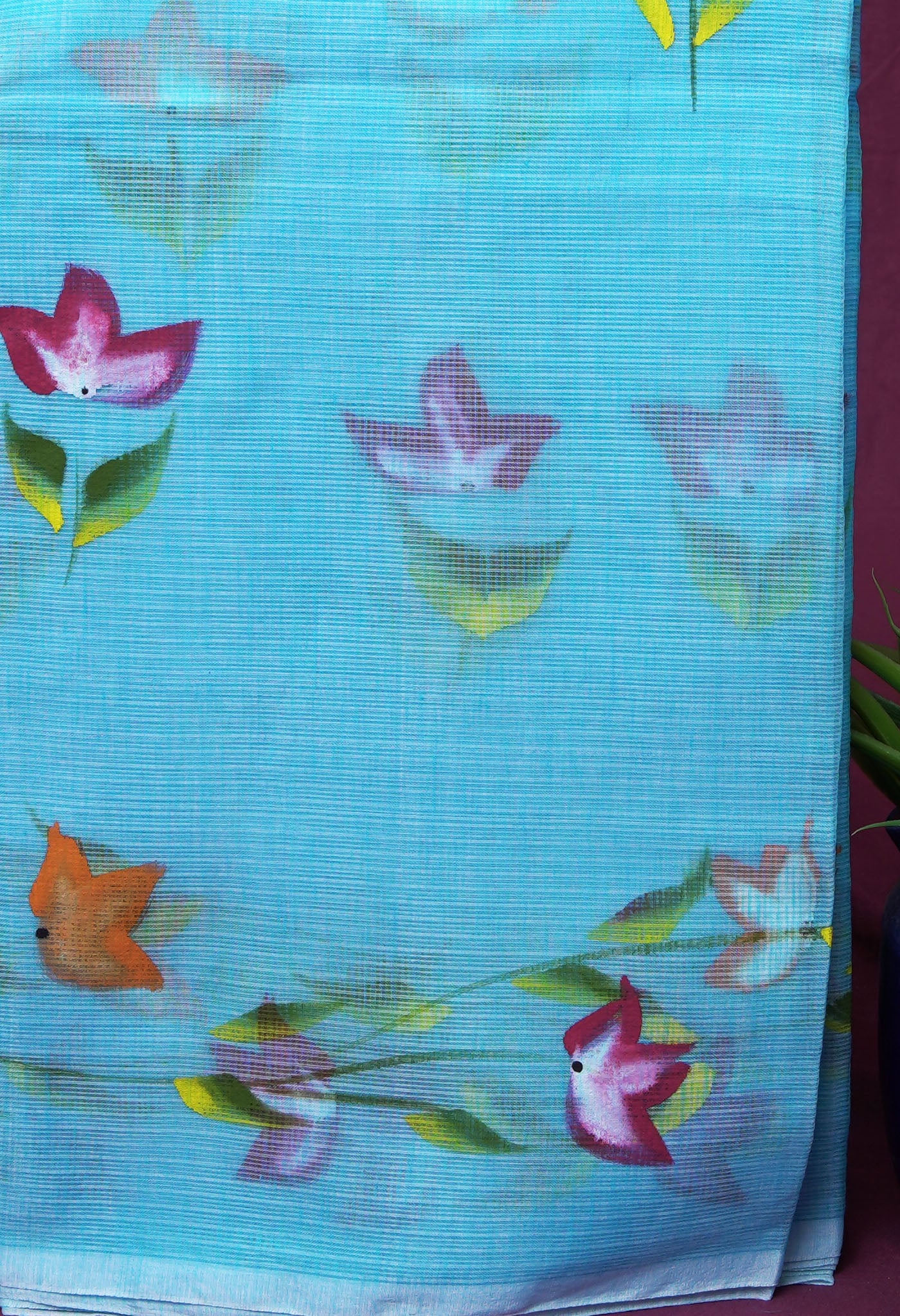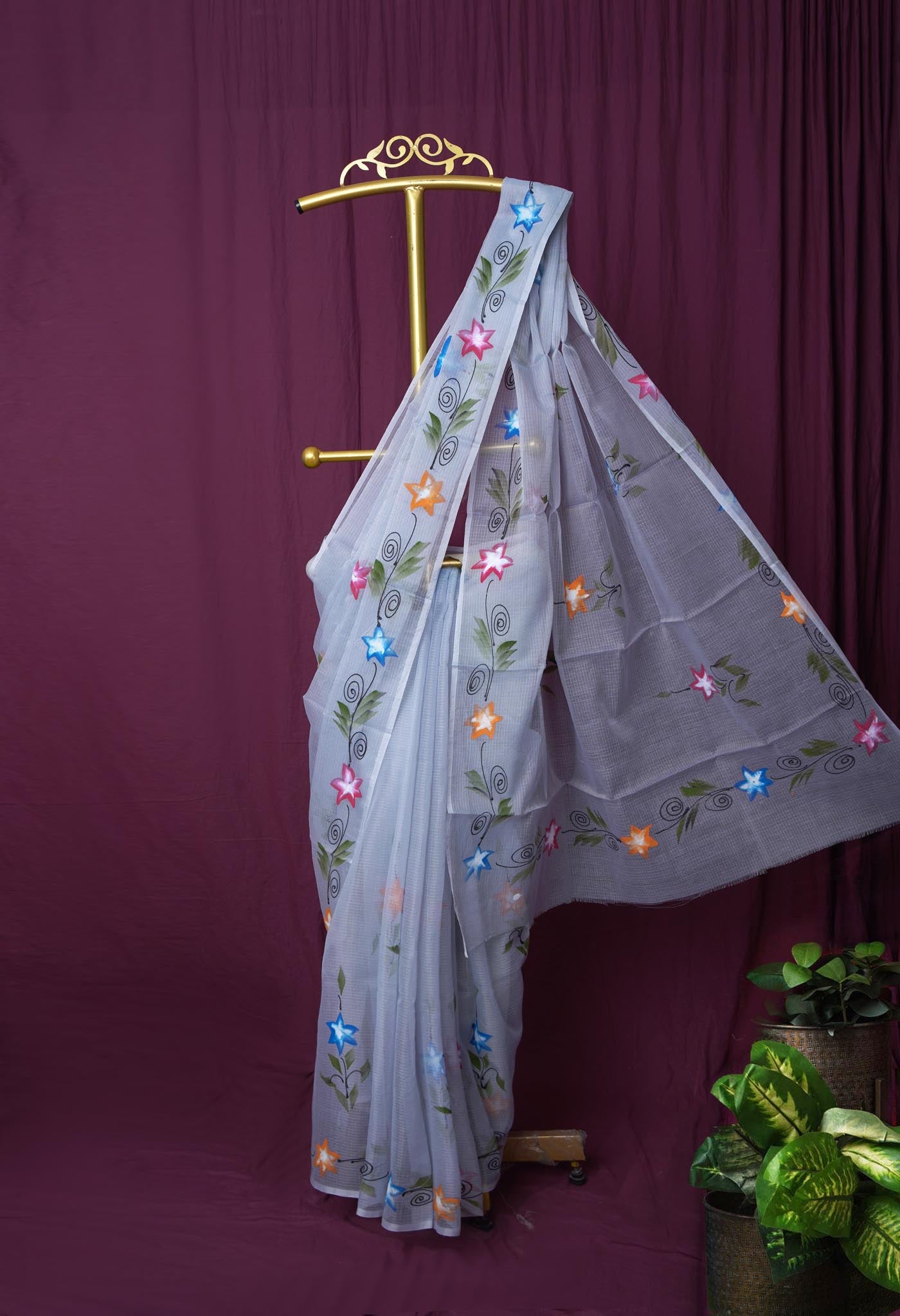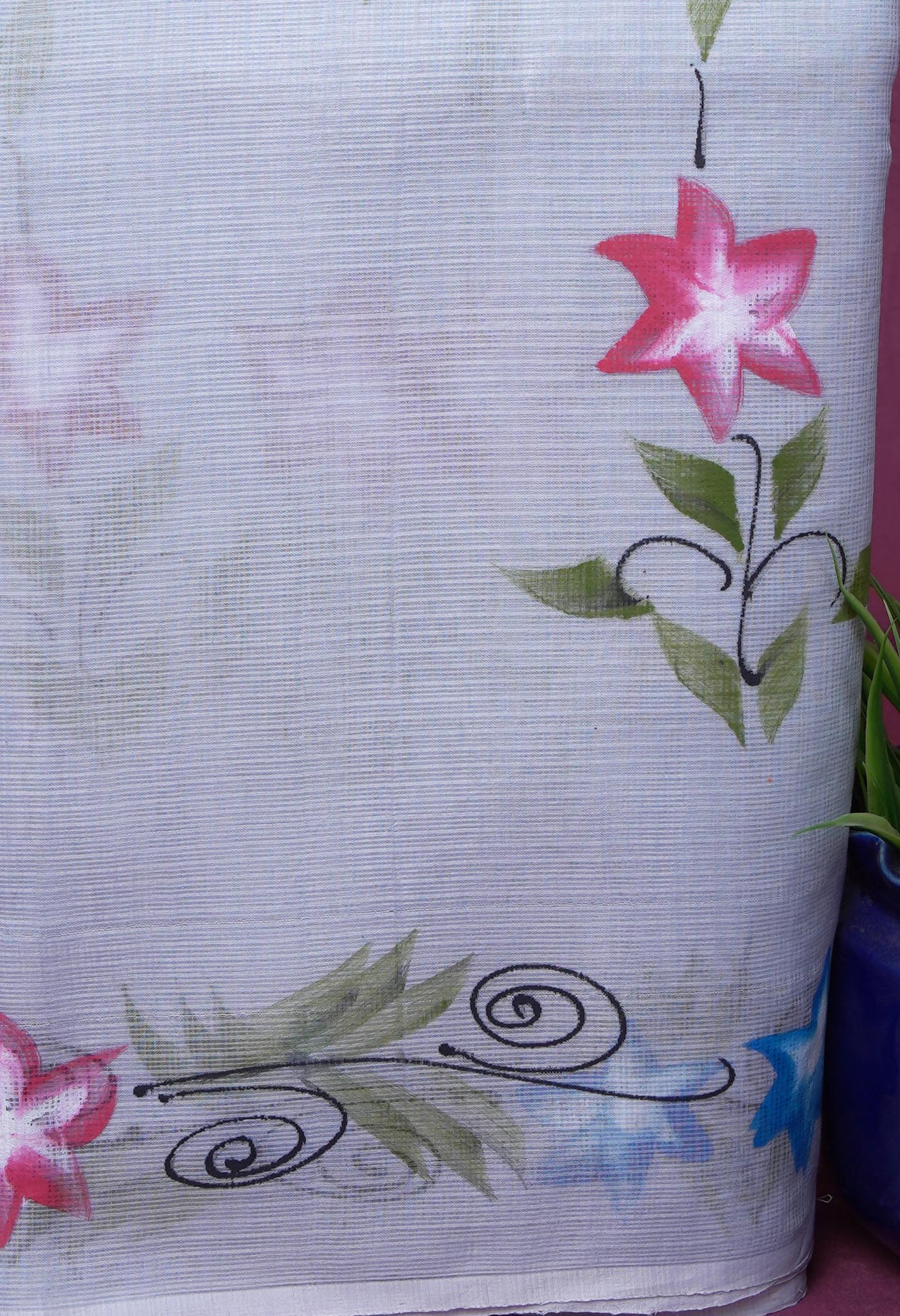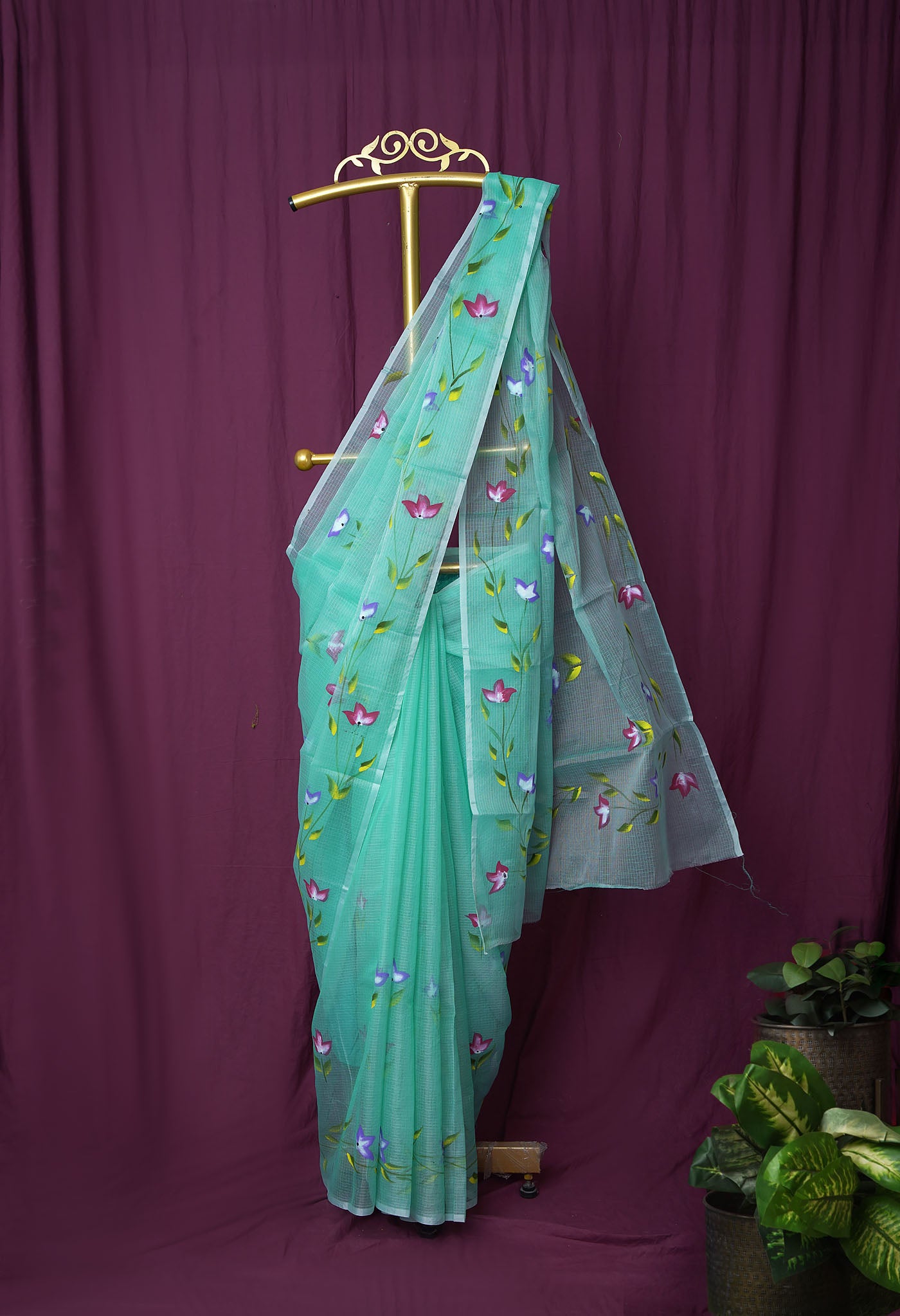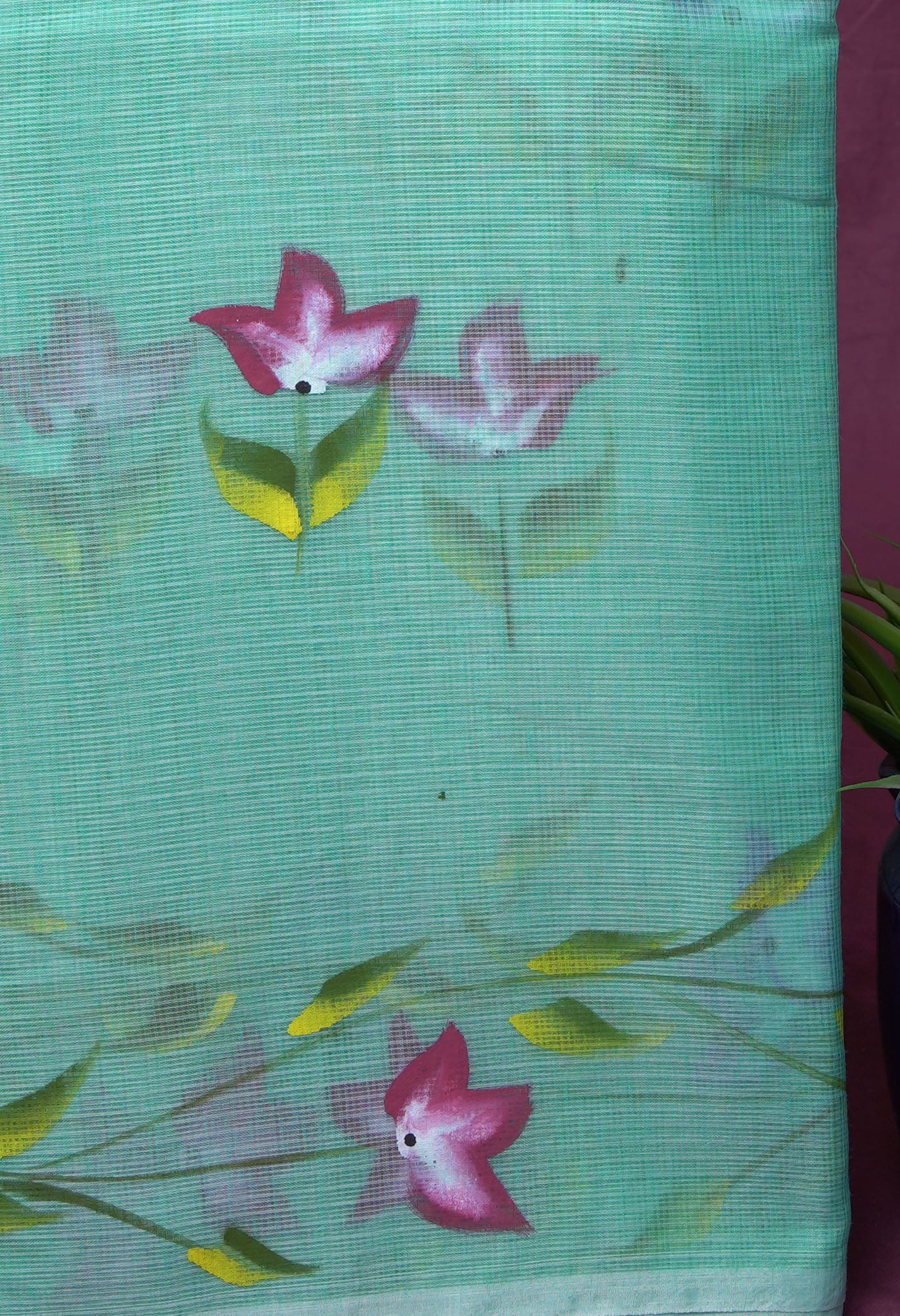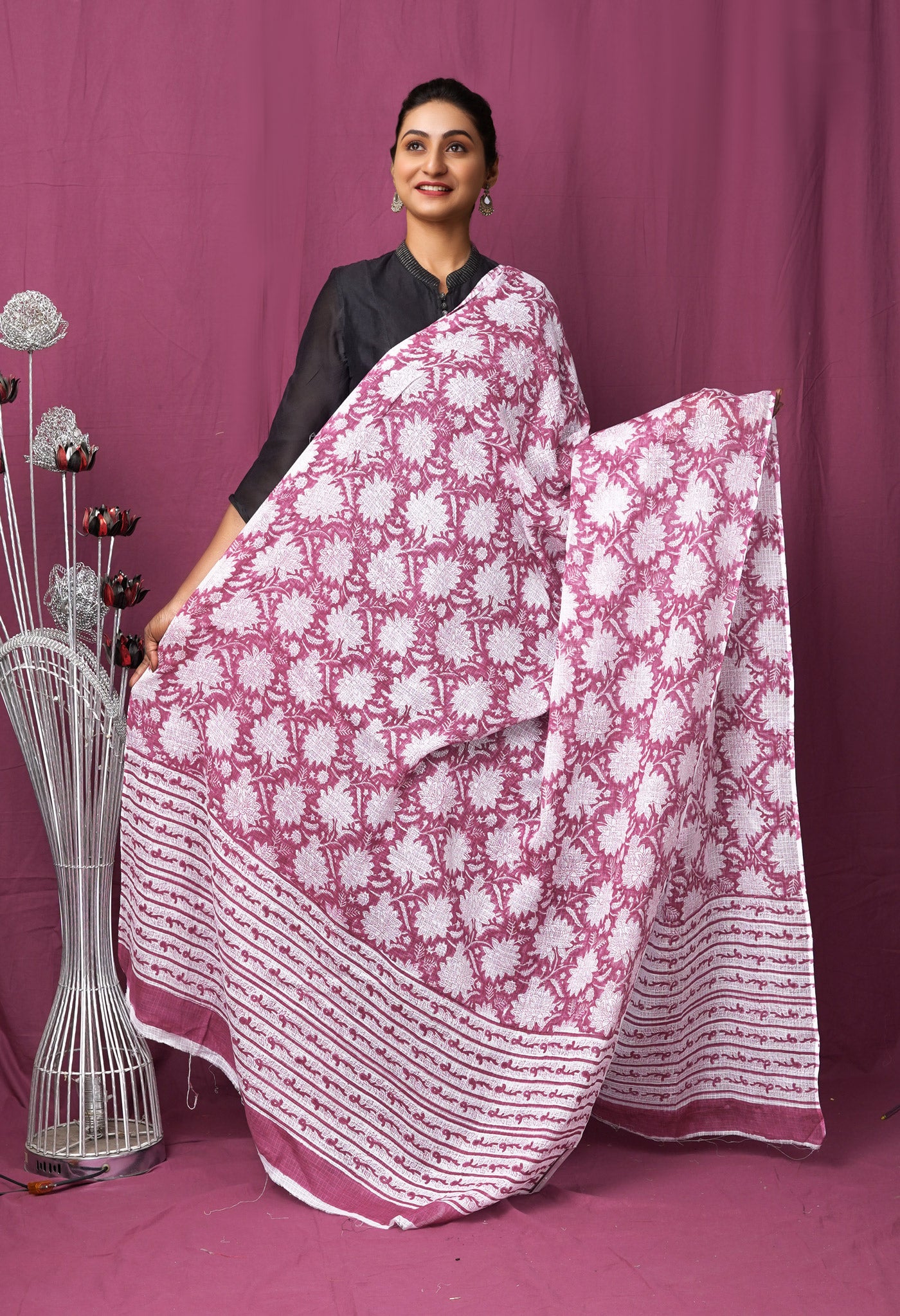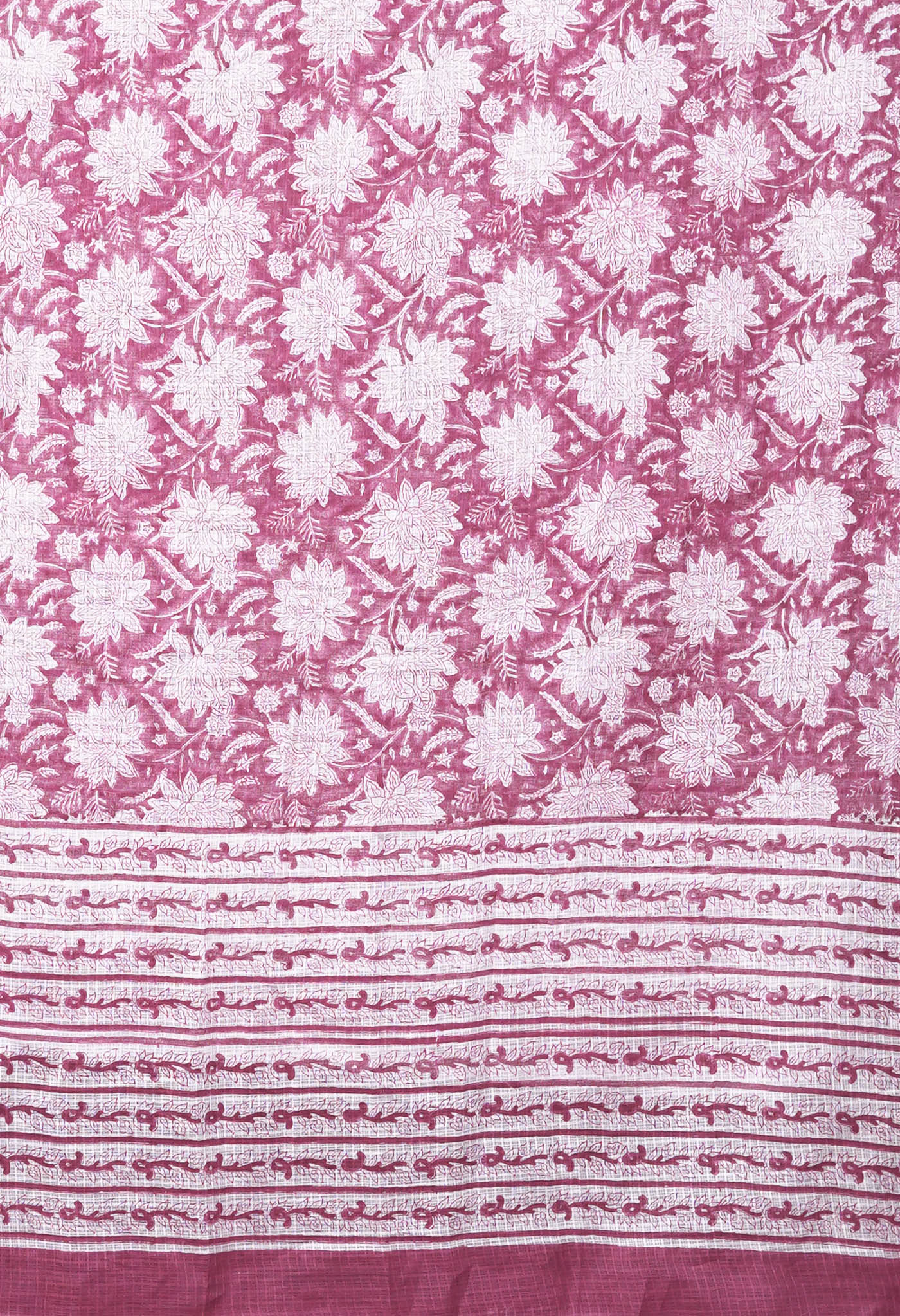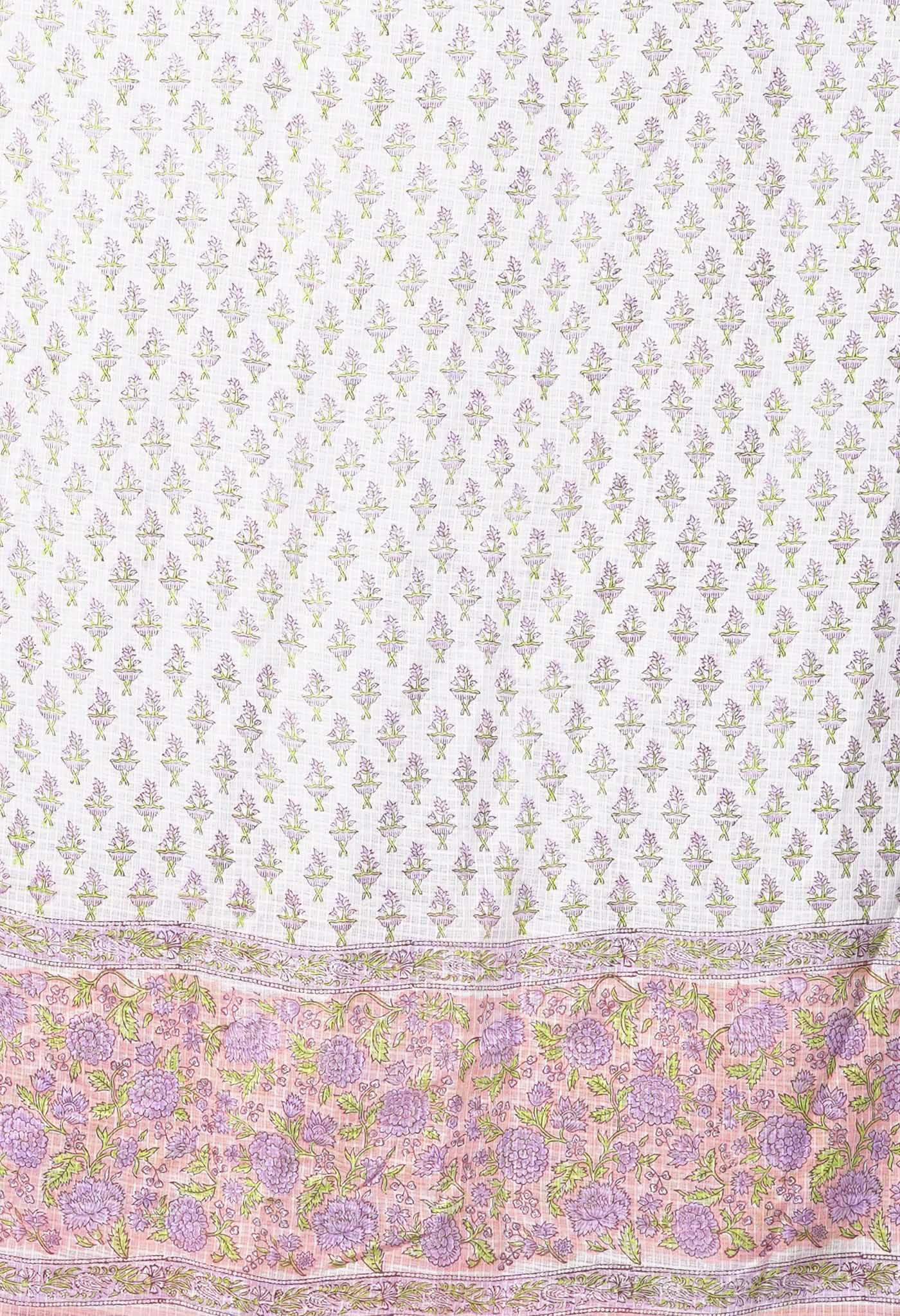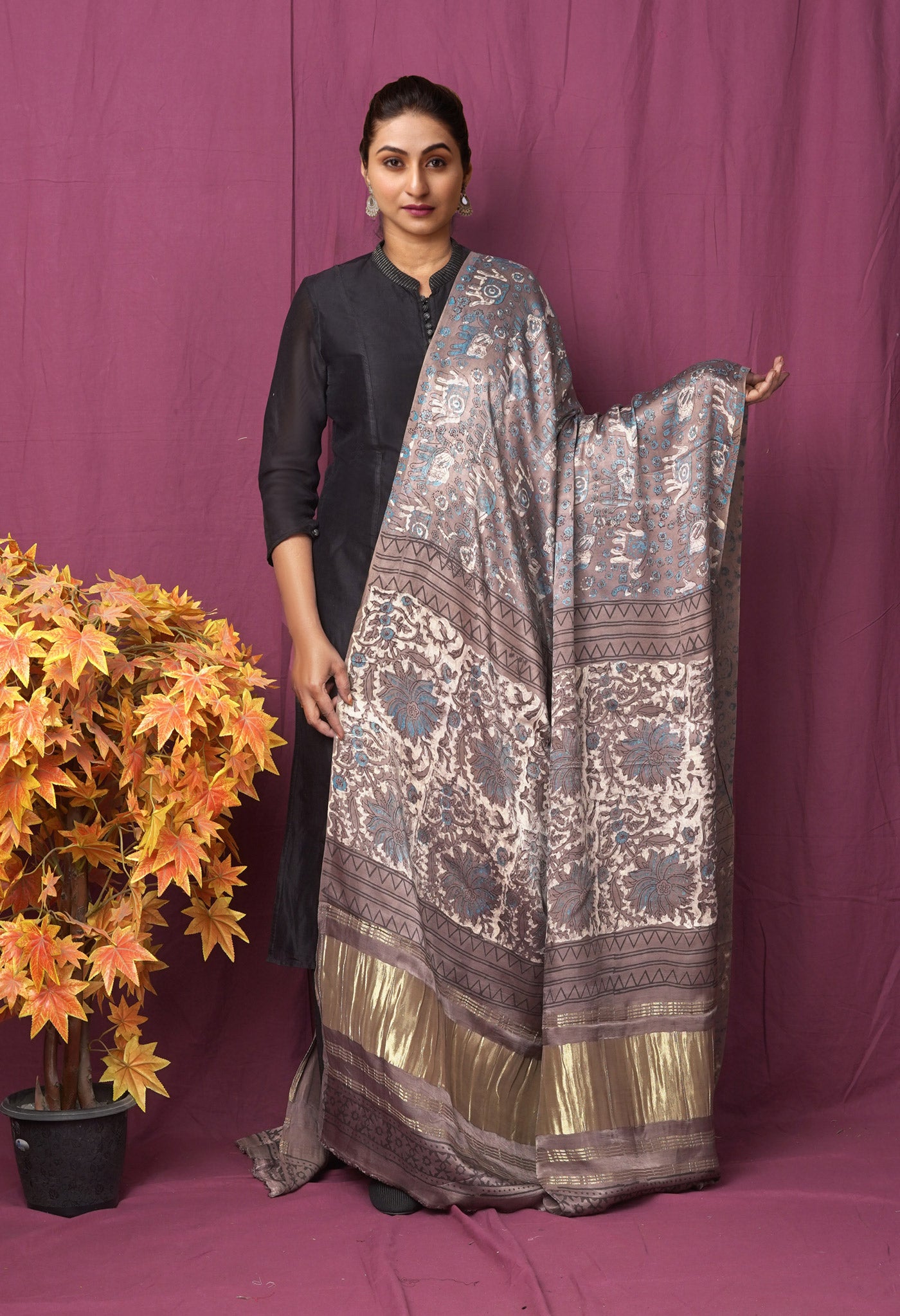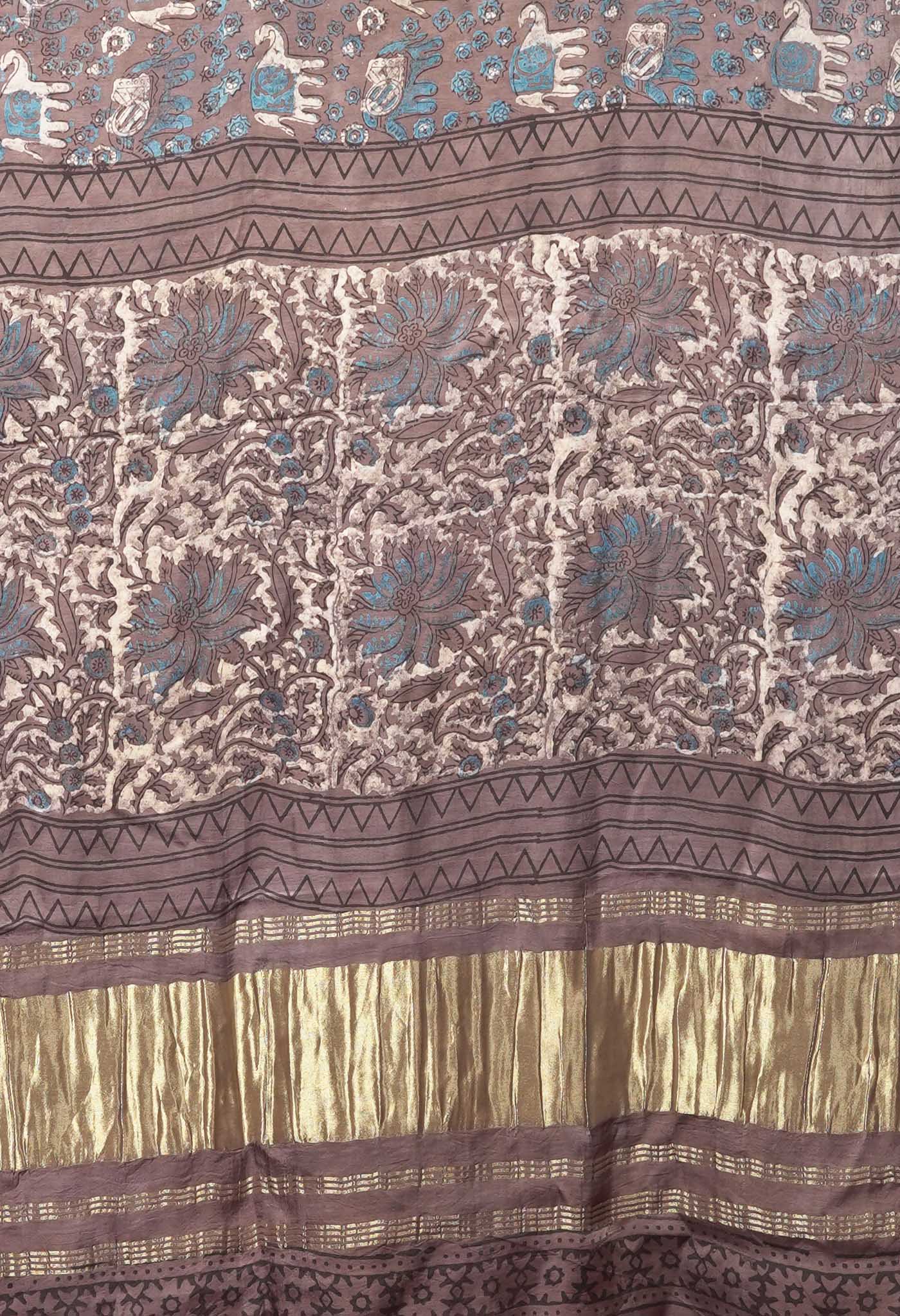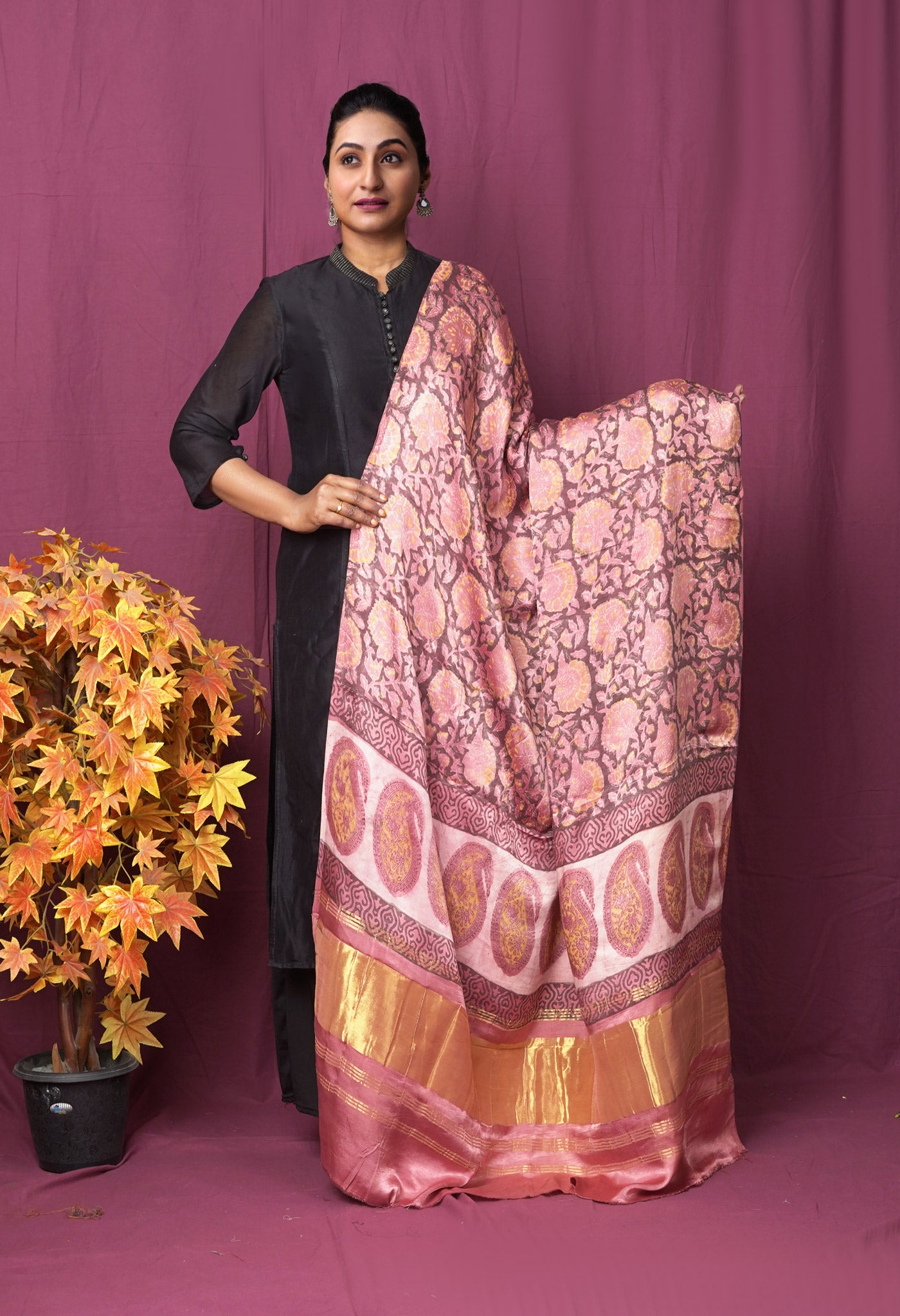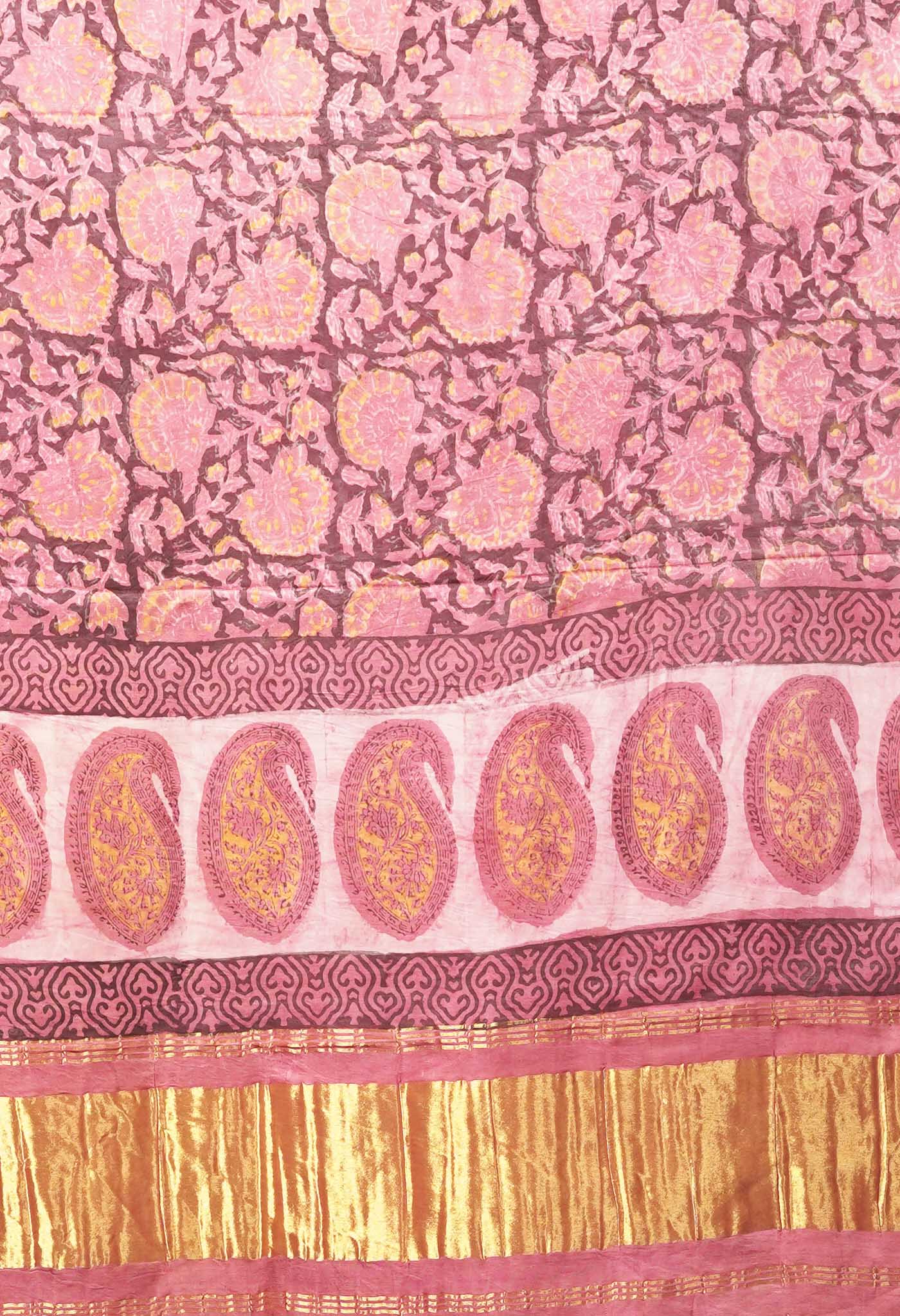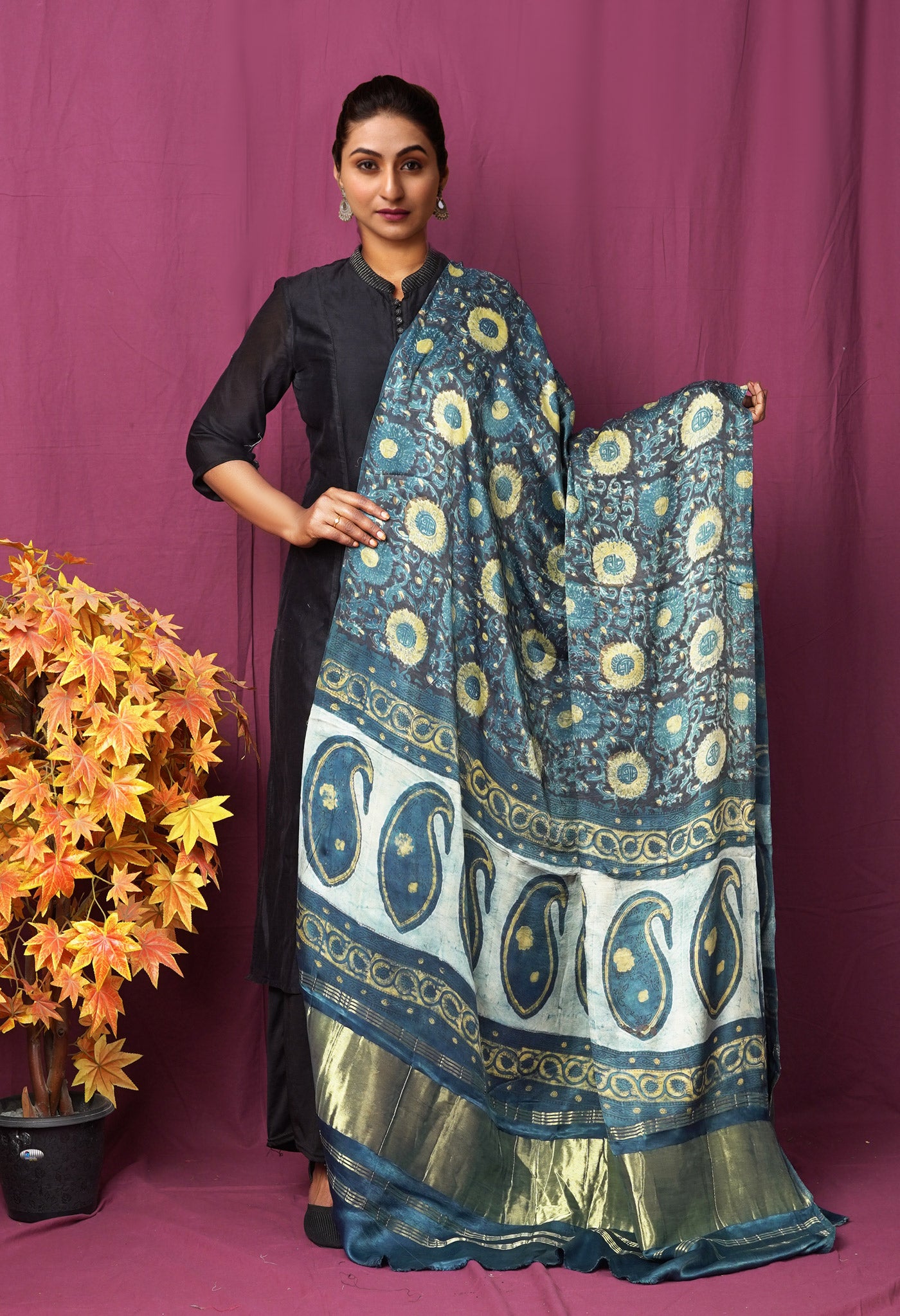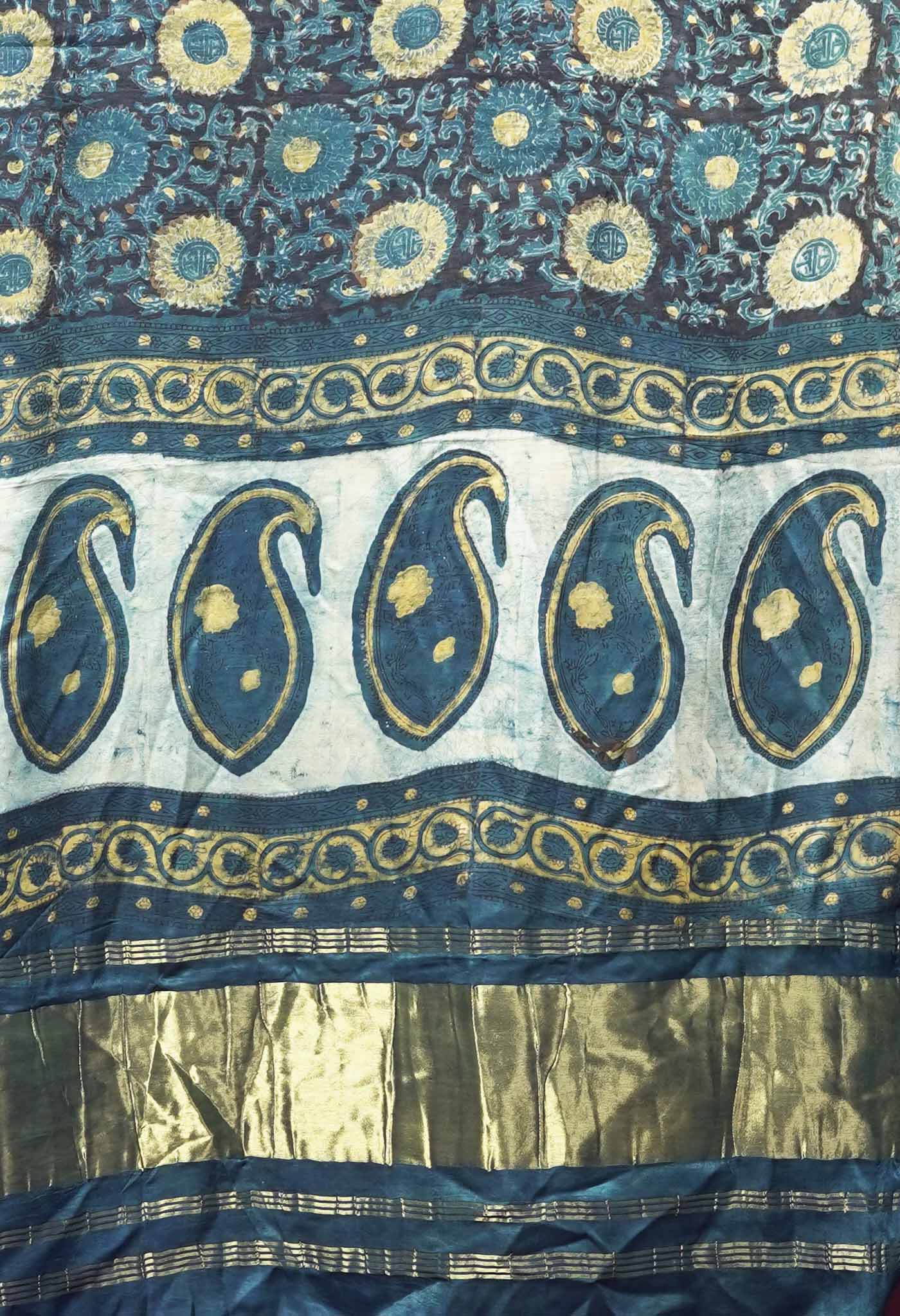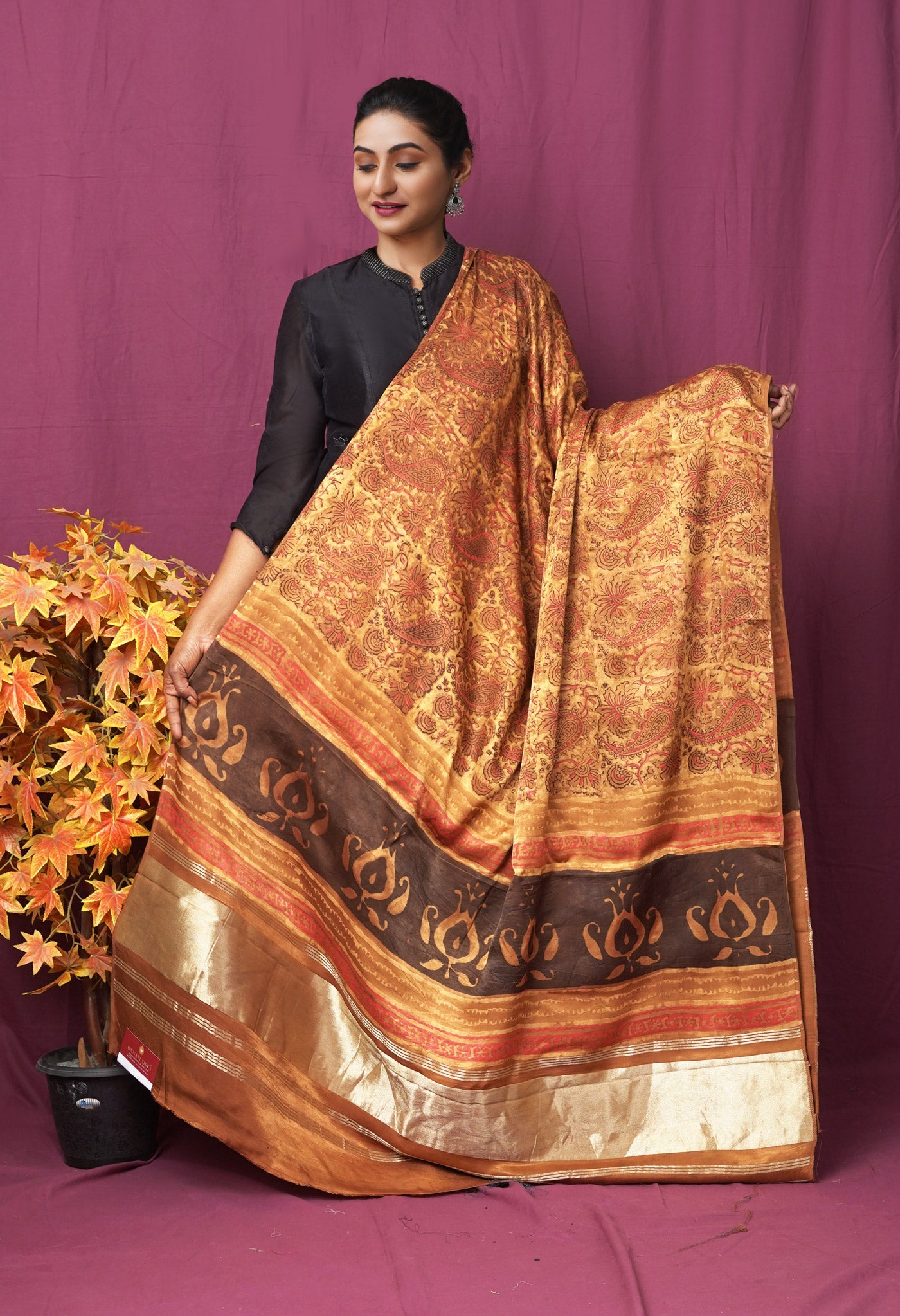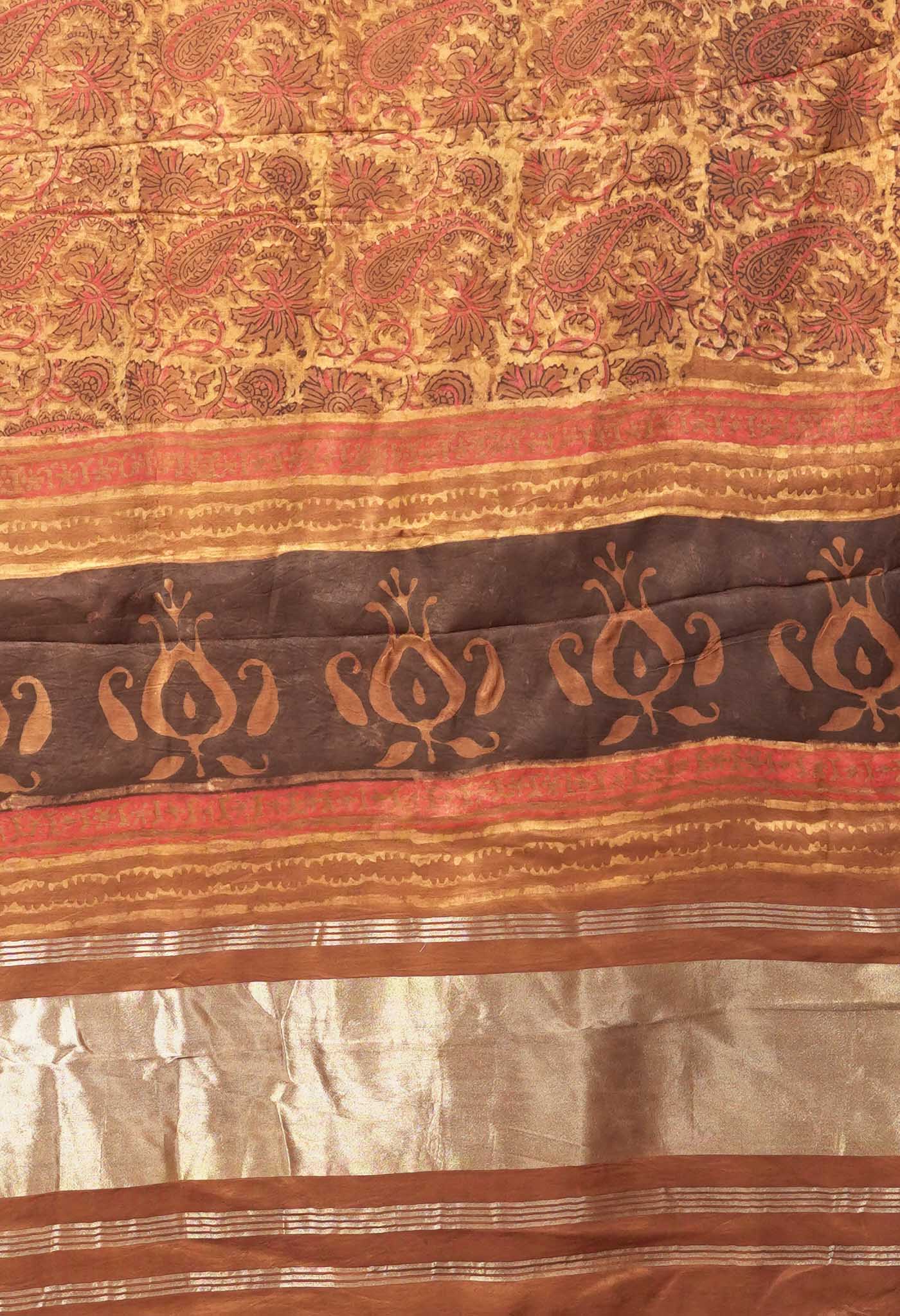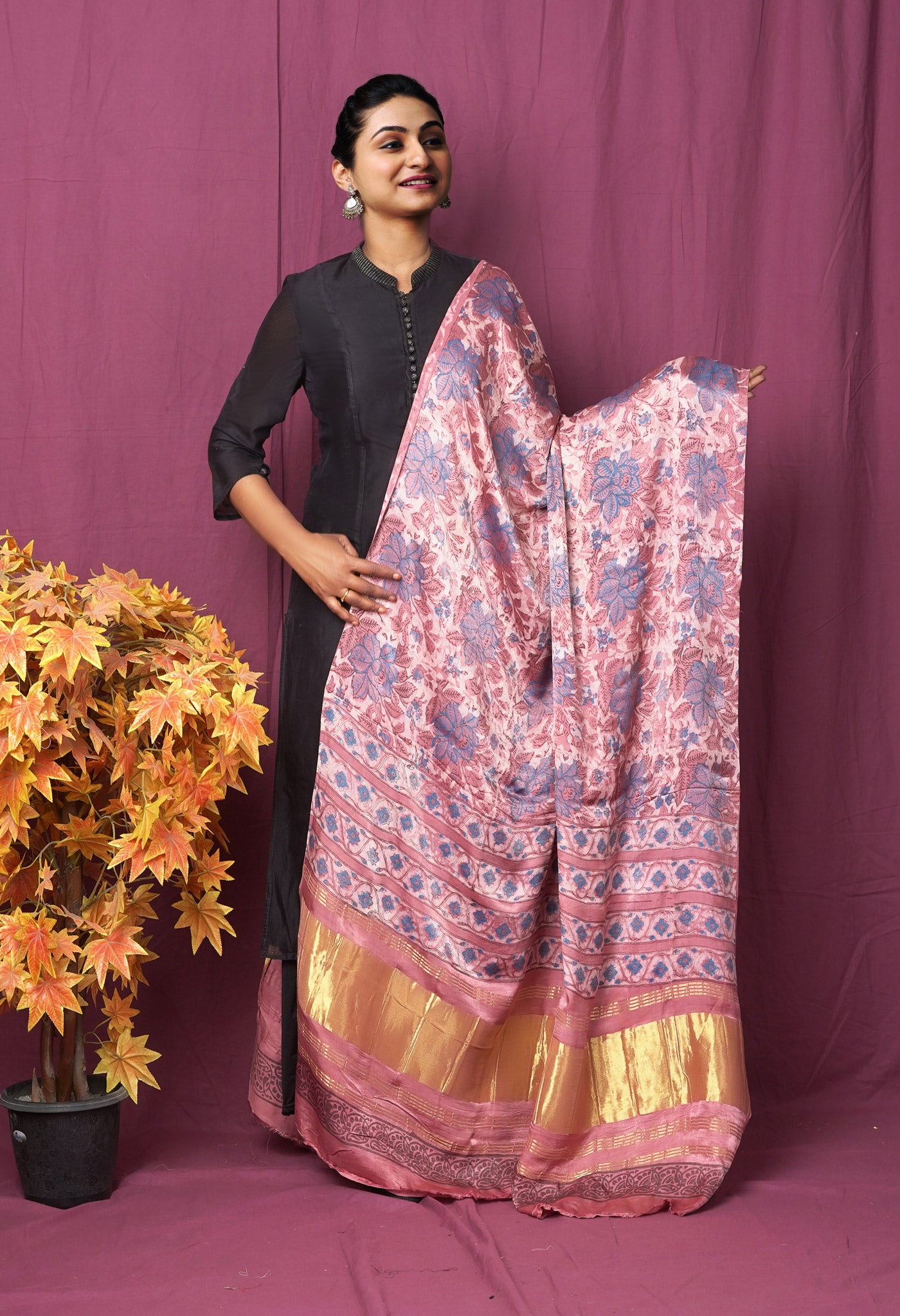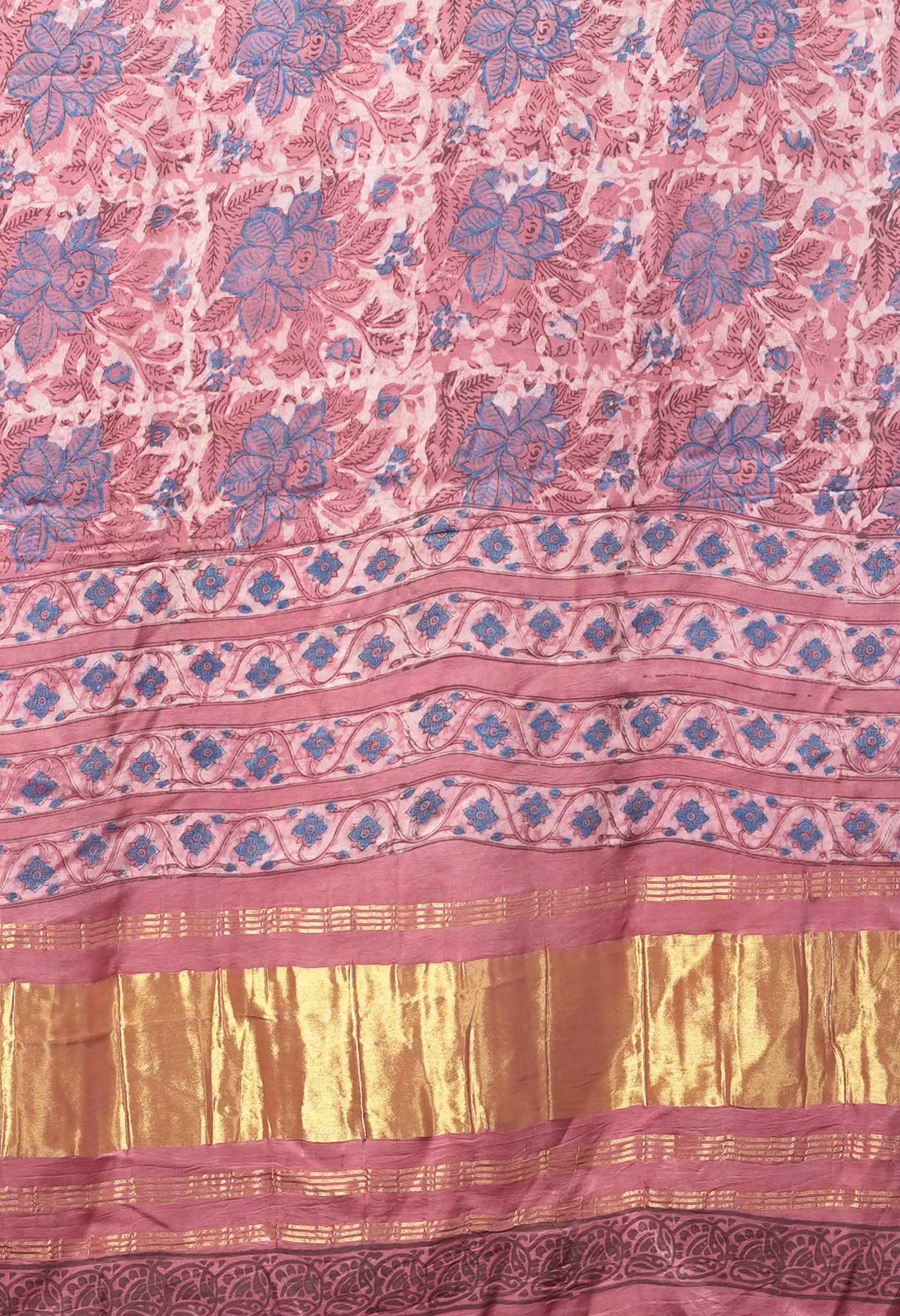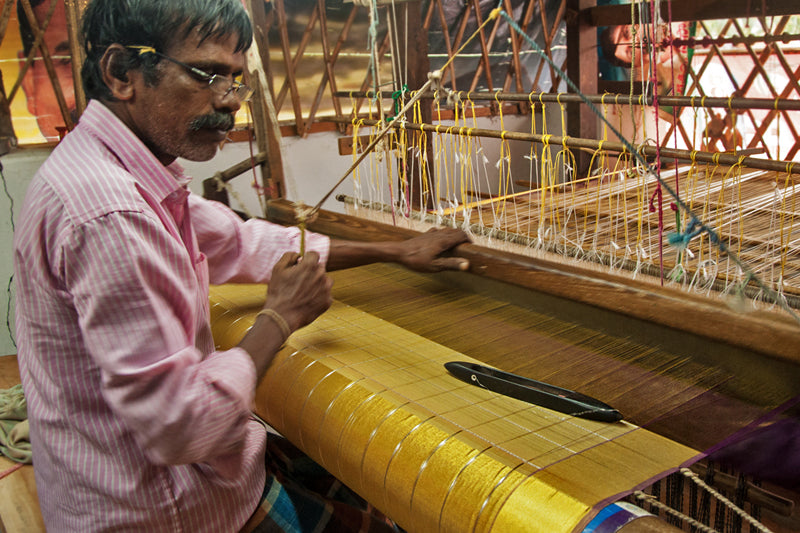
While the Handloom weavers are suffering in rest of India, Telangana Government is working harder than ever before to improve Handloom Culture in the state
Telangana was formed on 2nd June, 2014. United Andhra Pradesh had always been considered as a major region for one of the finest handloom weaves in the country and after the bifurcation occurred, some of the handloom hubs came to the Telangana lot, the others going the new Andhra Pradesh state’s way.
The Telangana govt. realized the importance of the textile industry that is second only to the agricultural sector in terms of workforce and employment potential. Hence the Chief Minister and the Textiles Minister, Mr.K.T.Rama Rao have given special attention to the textiles industry and its handloom sector that contributes significantly to exports as well as domestic consumption.

Here the Handloom sector that has a clan of traditional practitioners in different clusters in certain pockets of the state, has been specially highlighted for what it currently is going through and what could change in the days ahead.
A timeline about different events that have occurred since the formation of the state and the major announcements and initiatives that have been made for the improvement of the sector in Telangana state is provided backwards – starting from the latest to the earliest.
The focus is on what the government has done so far for the handloom sector and what changes it intends to bring about in the coming days.
Telangana Govt.’s major announcements & policies about handloom sector till date
1. From https://www.facebook.com/itministertelangana/Minister for IT, Telangana 17 December at 19:22
An IT Handloom Mela is being organized from 19th to 21st December, 2017 to support our weavers. Do participate in the #IWearHandloom initiative of Facility Management Council. This was posted by Mr.K.Rama Rao, Minister for IT as well as Handloom & Textiles on his Facebook Page, inviting people to make the event a success.
With nearly 10,000 IT employees visiting 40 plus stalls, the three-day IT Handloom Mela organised by Facilities Management Council (FMC), the professional body of Facilities Management industry in the Telangana State, at Art & Cultural Centre - Phoenix Arena in IT corridor proved to be a hit.
“Over a three day period, a handloom sale of around Rs 8 lakh has taken place," informed FMC President Satyanarayana Mathala in the press release. “There are 400 IT/ITes companies in the city and more than four lakh employees work in them. If they all start wearing handlooms at least once in a week on Monday, it will receive huge fillip to the handlooms weavers”.
FMC is actively working with Government of Telangana to encourage Handloom Mela in feature. FMC formed a core team to organize the handloom Melas in various IT parks for the year 2018.
"Our objective is to cover all the IT parks in and around Hyderabad. We are working hard towards this. We made all our members take pledge that they wear Handlooms clothes only on Monday. Everyone must encourage and support to uplift handloom industry to restore its last glory," said Mr. Satyanarayana.

2. In November 2017, Minister for Textiles K.T.Rama Rao, after a review meeting with ministry officials instructed the expediting of the following:
- waiver of 10.5 crore loan – the aim was to benefit 2500 handloom weavers with each weaver receiving the benefit of waiver upto one lakh
- setting up of handloom and power loom corporations, especially instructing principal secretary Jayesh Ranjan and Shailaja Ramaiyer, director of handlooms and textiles to complete the formalities for setting them up to ensure allocation of corpus funds
- implementation of subsidy for yarn, chemicals & dyes from first week of November
- administrative sanction for a handloom park in Gadwal city
- boosting the handloom sector in the state
- ensuring the subsidy of 40 per cent is extended to the handloom sector and 10 per cent to the power loom sector in the State
- conduct of special drives to get every weaver enrolled in the recently launched Weavers’ Thrift Scheme
3. Warangal will become a textile hub in the country: KTR
On October 23rd, 2017 , Industries Minister K T Rama Rao, along with Deputy Chief Minister K Srihari presided over the signing of memorandums of understanding (MoU) with textile companies from across the country, including a Korean company, in Hanamkonda.
The Minister said that Warangal would soon become a hub and favoured destination for textile industry. One member of a family would be given training and would be offered a job at the park.

Speaking about the park he mentioned that the park would be established with international standards without causing any pollution. The proposed Kakatiya Mega Textile Park would address end-to-end needs of textile industry on the basis of farm to fashion functionality. All the latest trends in textile industry would be incorporated in the products from the Textile Park.
To ensure this, PSG College of Engineering of Coimbatore in Tamil Nadu, which offers courses in Textile and Fashion Technology, and National Institute of Fashion Technology (NIFT) have been roped in and they would set up their campuses at the park, he informed.
Both the Minister and the Deputy CM Srihari while thanking companies that had come forward to invest in the Mega Textile Park, ensured that an encouraging environment to carry on their business would be provided. The Deputy CM had appealed to the Textiles Minister to set up a Textile Incubation Centre and Skill Development Centre in Warangal to offer training to the youth and the weavers in the State.
On the day, as many as 13 textile companies signed MoUs with the state government. Suryavanshi Spinning Mills, Suryauday Spinning Mills Ltd, Srinath Spinning Mills Ltd, Urbaknitt Fabs, Shivani Group, Ginni Filaments, The Swayamwar Group, Yougone Corporation (South Korea) Gokaldas Images, Nandan Denim (Chirpal Group), Shahi Exports, Jaycot Industries and GK Threads.
One more company Welspun Group will sign the MoU on October 23. These companies are expected to invest a total of Rs 3,020 crore at the Textile Park and create 22,350 jobs through direct employment and 66,000 jobs indirectly.
Eight other companies - Suryalatha Spinning Mills, Seetharam Textiles, Suryalakshmi Cotton Mills, Sri Ram Spinning Mills, GMR Spintex Pvt Ltd, Vijayalaxmi Spitex Pvt Ltd, Ashtalaksmi Spinning Mill and GTN industries - have also singed MoUs agreeing to invest Rs 380 crore in other districts of Telangana.
The above companies would create 1,450 jobs was mentioned.
MPs P Dayakar and A Seetaram Naik, MLAs D Vinay Bhasker and K Surekha, MLC K Muralidhar Rao, GWMC Mayor N Narender, industries department principal secretary Jayesh Ranjan, handloom and textile secretary Shailaja Ramaiyer and TSIIC chairman Bala Mallu were present on the occasion.
4. KTR inaugurates textile exhibition on National Handloom Day
In August 2017, the Telangana textiles minister while inaugurating a textile exhibition on the occasion of national Handloom Day, said that for the first time Rs 1283 Crore had been sanctioned for the Textile industry. Initiating Geo Tagging process to learn the number of families depended on Textile industry and power loom sector with the help of Information and communication Technology, the state government had managed to provide 50 percent subsidy for chemicals, yarn and dyes. KT Rama Rao said “The state government had identified 17,000 handlooms in Telangana and geo-tagged them as part of a state-wide survey. The survey helped us identify problems being faced by weavers and handloom industries, encouraging us to initiate various welfare programmes, including subsidy on yarn, Pavala Vaddi scheme, block level clusters and handloom savings schemes among others”.

5. Telangana Textile and Apparel Incentive Scheme 2017 .
On Handloom Day on 8th August 2017, Amazon India signed an MoU with Telangana Department of Handlooms and Textiles, as part of which it would educate, train and enable weavers and artisans to directly sell their products to Amazon customers across the country. The e-Commerce portal would train Telangana weavers through this arrangement would help them boost their business by training them to list and sell their products online on the marketplace.
The announcement in the media spoke of handloom products from clusters such as Pochampally sarees, Warangal, Gadwal sarees, Narayanpet sarees and Siddipet, that had tremendous potential, especially in the urban areas, benefitting from this initiative. There are 17000 handlooms in the State.
Additionally, Amazon India would in collaboration with the Department conduct training programmes, including computer and internet training sessions and registration assistance programs.
Besides providing an online marketplace for marketing, Amazon India would also engage with weavers and artisans to train them on making the products more attractive, appealing and marketable across the online domain, the release said.
MoU signed
The MoU was signed at the National Handloom Day event, in which Minister for Handlooms and Textiles K. T. Rama Rao participated.
“With their rich experience and deep understanding of consumers, Amazon can really make a difference in facilitating these gifted artisans and craftsmen to take advantage of the growing digital economy and e-commerce,” Principal Secretary (Industries) Jayesh Ranjan had said during the occasion.
Director and general manager – Seller Services of Amazon India Gopal Pillai said the partnership would give a boost to the local ecosystem and catalyse the economic development of the weaver community.
In mention, Telangana state is known for its production of long staple cotton, with an annual production of about 60 lakh bales. processing and value addition to cotton in the State is largely limited to ginning and pressing. 10 lakh bales are utilized by the 35 Spinning Mills having a capacity of 9.3 lakh spindles located within the state. Primary processed cotton from Telangana is being exported to states like Gujarat, Maharashtra, Tamil Nadu and Andhra Pradesh for further value addition. Lakhs of textile workers employed in well-established clusters in the country like Surat, Bhiwandi, Sholapur and Ichalkaranji are natives of Telangana, and have 3-4 decades of experience of working in this sector.
6. KTR invites textile industry to Telangana
In July 2017, Textiles Minister of Telangana, Mr.K.T.Rama Rao, was invited to the Textile India Summit at Gandhinagar, Gujarat, that was inaugurated by Prime minister Modi. Highlighting the need for a national policy for promoting textiles, which he said was the biggest employment generating sector after agriculture, he spoke about how the Telangana Govt. recognized the importance of the Textile sector and had resolved to establish a ‘Mega Textile Park’ in Warangal.
In line with its ‘Meet or Beat’ policy, the Telangana government is ready to offer opportunities that will either match or supersede any package offered anywhere in the world for industries, Mr.Rama Rao had said. He remarked that `Meet and Beat' offer has attracted the attention of more than 150 national and international investors. My offer is to "meet the level of incentives being offered by different states and offer more than that".

“Though 60 lakh bales of cotton are being produced in Telangana, only 10 lakh of them are being used”, he said.
He further elaborated about the ease of doing business in Telangana, that offered the best environment for manufacture and how simple the process of ‘obtaining permissions’ was, which went down very well with the audience.
Later at the CEO Round Table meeting he mentioned about how attractive Telanagana had become to be considered a suitable destination for investments. He repeated his invitation to those present to similarly invest in Telangana since the govt.’s textile policy was as revolutionary as its industrial one. Cotton produced by Telangana, he added, was of very good quality and they could take advantage of it.
Speaking about the envisaged Mega Park to be constructed at Warangal in the near future, he said the motto of the Park would be “Fibre to Fashion” and it would include international fashion products s well. Housing would be provided for workers within the park. There would be an institute along the lines of PSG Institute Coimbatore within the campus where skill development programmes for the weavers would be offered.
Union Minister for Textiles Smriti Irani, and Chief Minister of Andhra Pradesh N.Chandrababu Naidu, were also present at the round-table.

7. In May 2017, minister for handlooms, industries and information technology, K Taraka Rama Rao had suggested the setting up a separate corporation for wide marketing and increase in sales of handloom items. The handloom industry would also receive incentives from the state and Centre for its development.
Figures that were quoted by him were:
- State's requirement of yarn – worth Rs.206 crore per year
- State govt. would support the handloom industry with 40 % input subsidy of Rs.82 crore apart from the 10 % subsidy assured by the Centre.
He said apart from financial help from the govt. the handloom weavers would be supported by the authorities and it would be their duty to increase demand for their items.
He appealed to government officials, party leaders and students of all state-run educational institutions to wear handloom clothes at least once a week to create a demand for handloom weavers.
The officials of the handlooms department of Telangana had carried out a study of the Co optex of Tamil Nadu in order to implement the Telangana model of the scheme along similar lines.
8. In Apr '17, KT Rama Rao, handlooms and textiles minister of Telangana along with the Chief Minister had a small meeting with officials from the handloom industry.
- The officials were asked by Mr. K. T. Rama Rao to formulate a handloom directory containing all the details of the weavers' condition.
- Policies should be made to directly give subsidy benefits to handloom weavers and it could be made available to them by linking their Aadhaar and biometric identities.
- In November 2016 Handloom products were under a tie-up to sell via various e-commerce platforms including Amazon, Flipkart and other leading online stores apart from the website of Telangana State Handloom Weavers Cooperative Society (TSCO).
- The state government would directly purchase handloom fabric from the weavers and also provide better marketing facilities for their handloom products. TSCO provides employment to nearly 13,000 handloom weavers of the state.
During the meeting Chief minister K Chandrasekhar Rao wished to have a detailed document containing information
- the number of handlooms,
- weavers and workers,
- production capacity of the units etc.
- number of silk, cotton and grey cloth weavers
- information pertaining to marketing facilities for purchasing their items.

He felt that the weavers should also get the opportunity to sell their items to the government as well as the outside market.
The government already provides 50 per cent subsidy on yarn to handloom weavers. The plan to set up handloom depots owned by the state in addition to National Handloom Development Corporation yarn depots was discussed.
9. Three-pronged strategy to solve problems of weavers
In February 2017 Chief Minister K Chandrasekhar Rao talked about a strategy to ensure that not a single worker committed suicide in the future.
The weavers (Padmashalis) working in the industry could be listed under three categories and steps could be taken especially in regions like Sircilla, Pochampally, Gadwal and Narayanpet regions in the state where the weaver clusters mainly were. Handloom textiles produced by them, such as Ikat, were world famous and in demand globally. Yet the community had been severely distressed by debt, unemployment and worse.
This was a major announcement from the state government that came for the first time, more than two years after the formation of Telangana that gave a shot in the arm to the beleaguered weavers.
The suggestion was that the weaving community would be divided into three categories — those who work on handlooms, those who worked on the power looms and those who left their age-old profession and were looking for alternative jobs.
For the handloom weavers, the government decided to offer financial assistance to those weaving general cloth. Subsidy would also be given on yarn and chemicals and the government would purchase the cloth woven by them.

10. Indian govt's weavers' helpline became operational in Jan '17
‘Bunkar Mitra’, the Government of India’s helpline for handloom weavers, became operational in January 2017. The helpline provides a single point of contact to handloom weavers across the country for addressing queries and providing guidance. Weavers can call from anywhere in India, from any number, and their queries would be answered by the experts in the field.
Union textiles minister Smriti Irani said that the helpline is a great mix of technology, youth and tradition. She told the officials of the ministry to monitor issues on which maximum complaints are received, so that corrective actions could be taken accordingly.
The new helpline can be accessed by dialling the toll free number 1800-208-9988. The service is available from 10.00 a.m. to 06.00 p.m. on all 7 days of the week, in seven languages: Hindi, English, Tamil, Telugu, Bengali, Kannada and Assamese.
Through the helpline, weavers can avail services related to assistance on technical issues, and also seek guidance for raw material supply, availing credit facility, quality control, access to marketing linkages, and information about various schemes and procedures to avail benefits.
11. Observations by the Chief Minister
In December 2016, when it drew his attention, the Chief Minister of Telangana, Mr. K.C.Rao studied the situation and came out with his own observations about the handloom weavers of Telangana.
- Weavers from the handloom sector have either taken up different professions or ended their lives due to lack of support for the sector.
- Most of the handloom weavers are currently working as labourers in the powerloom industry.
- The handloom sector is in a crisis and there is a need to create a market for its products. The government can place orders for various handloom products to keep the industry running.
- Specialty brands like Gollabhama sarees online from Siddipet need to be encouraged and their past glory should be restored. They are essentially cotton sarees, which are embellished with figure works and motifs. The art of weaving this variety of saree is on the verge of extinction.
- He suggested giving subsidy to yarn and buying the existing stocks from weavers.
- The government's goal is to ensure that the state’s handloom workers generate an income of between Rs 15,000 and Rs 20,000 per month. “Instead of handloom workers in Siricilla and Pochampally committing suicide, they should be known for leading a life with confidence,"
- The government would procure fabrics from these two sectors during festivals and other occasions. As part of the plan, the government would place more orders for uniforms for school children, police and hospitals.

12. Handloom weavers may get 3-fold hike in insurance cover
In November 2016, the Union Textiles Ministry put down a plan for increasing the insurance cover of handloom weavers. The scheme involved a rise in the insurance cover for handloom weavers. The existing insurance cover in the case of natural death was Rs.60000 and in the case of accidental death cover it was Rs.1.5 lakh. The new proposed cover was Rs.2 lakh and Rs.4 lakh respectively. Insurance cover to handloom weavers in case of natural and accidental death and total and partial disability is provided under the Mahatma Gandhi Bunkar Bima Yojana. The move would get more weavers to get covered in the insurance net and attract more people to join the sector's workforce.
In the year 2015-16, under the insurance scheme, the government had released Rs 16.67 crore, which is slightly higher than Rs 16.39 crore—the sum was released when 5.74 lakh weavers were enrolled in the year 2014-15.
Out of 110 million people employed in the textile sector, more than 60 per cent are in handlooms.

13. Solar Charkas replaced conventional hand operated spinning wheels.
In March 2016, the khadi sector got a pleasant surprise. Traditional hand-operated spinning wheels were replaced with solar-powered charkhas as part of a pilot project in Andhra Pradesh, that if viewed as successful would transform the lives of the spinners of yarn. This was part of an initiative by the Khadi and Village Industries Commission (KVIC), that aimed to reduce the drudgery of spinners, boosting productivity and improving their livelihood.
The solar-driven wheel can produce up to 75-90 hanks of yarn in eight hours as compared to the 25-30 hanks made by the hand-spun charkha. Another advantage is that they let artisans to work at their convenience, saving time and energy. The artisan could therefore earn Rs.350 per day as against Rs.140 on a conventional wheel.
A total of 10 charkhas were sourced from Gujarat-based Udyog Bharti under the Prime Minister's Employment Generation Programme, each costing Rs.72,000. The solar-powered charkhas were installed in various khadi institutions located at Anakapalle, Tuni, Narasannapeta, Vemulapudi, Krishnapuram, and Visakhapatnam.
Schemes for the handloom industry in Telangana
From the time the present government took over, there have been announcements and framing of policies for the handloom sector that have evolved to take shape as given below.
1. INTEGRATED SKILL DEVELOPMENT SCHEME
The Ministry of Textiles, Govt. of India has launched ISDS for Handlooms & Textiles Sector during the 12th Five Year Plan. The objective of the scheme is to cater to the needs of Textiles as well as Handloom Industry in terms of providing skilled work force by imparting various skill development programmes to the unemployed youth and to provide placements.
The Government of India has fixed a target of 3,360 candidates to the Telangana State. An amount of Rs. 252.00 lakhs has been apportioned and deposited in the Bank. The State Government have released an amount of Rs. 63.01 lakhs towards its share @ 25%.
The details of Sector-wise in which training to be imparted are as follows:-
- Textile Sector (Powerloom Weaving)
- Garment Sector (All Courses)
- Spinning Sector
- Technical Textiles

The funding under the scheme will be shared both by the Government of India and State Government in the ratio of 75:25. As envisaged an amount of Rs. 10,000/- per candidate has to be released towards providing Training and infrastructure to the Training Partner. An amount of Rs. 10,000/- per candidates will be shared @ ratio of 75:25 by GoI and State Government i.e., Rs. 7500/- from GoI and Rs. 2,500/- from State Government.
The training under ISDS is being imparted to candidates through NGOs in the State.
2. INTEGRATED HANDLOOM DEVELOPMENT SCHEME (IHDS)
- Clusters: (2007-2011)
22 Handloom Clusters have been sanctioned with an outlay of Rs.1278.565 lakhs and Central Share of Rs.652.709 lakhs and State Share of 85.348 lakhs has been released to implement the scheme for the benefit of 8941 weavers so far.
- Handloom Groups: (2008-2011)
86 Handloom Groups have been sanctioned under the Integrated Handloom Development Scheme with a total outlay of Rs. 4.08 cr for the benefit of 1675 weavers and an amount of 2.97 cr as 1st and 2nd installment of Central Share and Rs.20.72 lakhs as 1 st and 2nd installment of State Share has been released. 223 work sheds have been sanctioned with a unit cost of Rs.25, 000/- as grant under the scheme.
- Marketing Incentive:
97 Primary Weavers Coop. Societies have been sanctioned and released an amount of Rs.13.96 cr towards Marketing Incentive for the years 2007-08 to 2011-12 under the IHDS. An amount of Rs.157.35 lakhs of state matching share for the year 2010-11 has been released during the year 2015-16.

3. COMPREHENSIVE HANDLOOM DEVELOPMENT SCHEME (CHDS)
Government of India has introduced a new scheme i.e. Comprehensive Handloom Development Scheme (CHDS) which is one of the components of National Handloom Development Programme (NHDP) by merging three schemes namely Integrated Handlooms Development Scheme (IHDS), Marketing and Export promotion Scheme (MEPS) during XII Five year plan.
(03) Handlooms cluster have been sanctioned with a total outlay of Rs.215.64 lakhs by GOI under Ist phase of the New Scheme CHDS and Rs.53.010 lakhs has been released as central share and Rs.6.84 lakhs as state share under 1st installment.
4. TELANGANA HANDLOOM WEAVERS THRIFT FUND SAVING AND SECURITY SCHEME (TFSSS)
- The Government of Telangana has issued orders increasing the State Government share in the Thrift fund scheme from existing 8% to 16% to the Thrift fund account in order to implement the new version of Thrift fund Scheme called Telangana Handloom Weavers Thrift Fund Saving and Security Scheme (TFSSS) – NETHANNA KU CHEYUTHA and also approved its operational guidelines. The new Thrift fund Scheme was launched by the Hon’ble Minister for handlooms and Textiles, Sri K.T. Rama Rao garu on 24.06.2017 at Pochampally in Yadadri Bhuvanagiri district. Unlike the old Thrift fund scheme, the new Thrift fund scheme is thrown open to all those involved in weaving job viz., weavers/Designers/Dyers/Warpers/winders etc both within and outside the Cooperative fold. An amount of Rs.60.00 Crores have been allotted under this scheme for the financial year 2017-18.
- Further, so far, an amount Rs.211.84 lakhs released to the Assistant Directors (H&T) of the districts to transfer the amount into the RD2 accounts of (5185) eligible beneficiaries, as Govt share of thrift. The enrolment of Weavers into the scheme is still in progress.

5. COOPERATIVE HANDLOOM WEAVERS THRIFT FUND SCHEME
- State Government has issued orders for implementation of the scheme w.e.f. 01.01.2011 as State scheme.
- An amount of Rs.1,47,96,249/- have been released towards thrift fund Scheme share amount to (85) Handloom Weavers Cooperative Societies for 17,296 weavers from 2011-16. • During 2017-18, vide GO.Rt.No.164,dt.21.07.2017, Rs.38,20,126/- release towards 8% matching State share under “Co-op HL weavers Thrift fund Scheme”
- Further, the old Thrift fund scheme named “Cooperative Handloom weavers’ Thrift fund Scheme” has been withdrawn from 30th June 2017 and in its place the new Scheme called Telangana Handloom Weavers Thrift Fund Saving and Security Scheme (TFSSS) will function and all the eligible must be migrated into the new scheme.
6. SCHEME OF TRAINING AND INFRASTRUCTURAL SUPPORT TO HANDLOOM SECTOR
- An amount of Rs.700.00 lakhs has been provided in the Budget estimate 2016-17.for undertaking infrastructural work in HWC Societies in the 1st spell, Rs.2,80,70,000/- has been released for sifting infrastructural project in Karimnagar, Warangal (U) and Siddipet District. In the 2nd spell, Rs. 2,61,90,000/-has been released for undertaking civil infrastructural works in Nalgonda, Yadadri, Karimnagar , Mahabubnagar and Jogulamba Gadwal Districts.
- Further during the year 2017-18 Rs.37.00 lakhs was released towards civil infrastructural works in Yadadri & Siddipet District.

7. MARKETING SUPPORT SCHEMES
A) EXHIBITIONS
- In 2014-15, 11 Expos were conducted 1- NHE, 4 - SHEs and 6 - DLEs with sales Rs. 645.83 lakhs effected.
- In 2015-16, 14 Events were conducted 1 - NHE, 4 - SHEs and 9 – DLEs with sales of Rs.761.41 lakhs effected.
- During 2016-17, 5 events were conducted 1 - NHE, 4 - SHEs with sales of Rs.431.01 lakhs effected.
B) HANDLOOM MARK SCHEME:
Scheme has been launched in 2006-07 to help the buyers in distinguishing the Handloom Products from the Mill 6 made products and also to improve the earnings of the Handloom Weavers for their artisanship and skill. 155 Primary Weavers Coop. Societies are registered under the scheme and 25, 46,488 labels sold so far.
 C) HANDLOOM (RESERVATION OF ARTICLES FOR PRODUCTION) Act, 1985
C) HANDLOOM (RESERVATION OF ARTICLES FOR PRODUCTION) Act, 1985- 11 Handloom varieties are reserved for exclusive production on Handlooms viz., Bed Sheet, cover, Durry, Dress Material Kambals / Blankets, Shawl, Woolen Tweed, Chaddar, handloom Sarees, dhoti, towel a) Gamcha b) Angavastram lungi
- Enforcement Machinery (Hyderabad and Warangal).
- Exemptions allowed in 1995 (45% Man Made Fibers).
- (28) FIRs filed and (20) cases were disposed, of which Hon’ble Court have imposed penalties in 9 cases, with pending cases in 7. There was 1 Case acquitted.
Pochampally Ikkat Sarees, Gadwal Sarees, Siddipet Gollabama Sarees, Narayanpet Sarees have been registered from the State of Telangana under Geographical Indication Act 1999.
8. MAHATMA GANDHI BUNKER BIMA YOJANA
- 16,754 weavers have been covered during the year 2014-15 so far. The scheme envisages risk coverage as well as providing scholarships @ Rs.1200/- per year to 2 children of a weaver family studying from 9th to 12th standards.
- Rs.60,000/- is provided for natural death, Rs.1,50,000/- for accidental death/total permanent disability and Rs.75,000/- for partial disability.
- 1054 scholarship have been settled by LIC of India so far.
- 162 death claims worth Rs.97.20 lakhs have been settled by the LIC during the year 2015-16.
- Recently a decision has been taken to substitute MGBBY by Pradhana Mantri Jeevan Jyothi Bheema Yojana (PMSBY)/Pradhana Mantri Subiksha Bima Yojana (PMSBY), for the weavers of age between 18-50 years and for 51-59 years weavers covered by MGBBY.
9. CREDIT SUPPORT
The District Cooperative Central Banks have sanctioned Cash Credit Limit for Rs. 967.96 Lakhs in respect of 95 Societies for the year 2013-14. During the year 2014-15 an amount of Rs. 12, 39, 78,000/- was sanctioned by the DCCB in respect of 119 PWCSs. During the year 7 2015-16 1537.50 lakhs has been sanctioned by the DCCB in respect of 125 societies. During the year 2016-17 Rs. 6128.37 lakhs has been sanction by the DCCB in respect of 290 societies.
10. PAVALA VADDI SCHEME
- Pavala Vaddi scheme is being implemented w.e.f. 1.4.2008 with a view to reduce the burden of interest on Handloom Weavers Coop. Societies, APEX Society, Individual weavers covered under Artisan Credit Cards and Weavers SHGs.
- An amount of Rs.3, 75, 34,000/- crores was released during the year 2015-16 for the 48 PWCSs.
- An amount of Rs.1,76,95,253/- has been sanctioned towards settlement the Pavalavaddi claims of Warangal, 30 societies Nalgonda 29 societies and TSCO, for the year 2016-17. The amount has been credited into the concerned accounts
During the Year 2017-18, Government have sanctioned an amount of Rs. 70,86,186/- and central to the 71 Societies of Karimnagar, Adilabad, Mahaboobnagar , Nalgonda and Yadadri Bhungiri District, and proposals have been submitted to the Government for an amount of Rs. 1,77,257/-, Rs.12,07,430/-, Rs. 8,09,364 and Rs. 4,82,069/- for issue of the Administrative Sanction.
11. 20% PRICE SUBSIDY ON HANK YARN, DYES & CHEMICALS
- 10% Price subsidy on Hank Yarn, Dyes & Chemicals is being implemented w.e.f.1.1.2008 to the Handloom Weavers Coop. Societies. Rs.1554.46 lakhs has been released benefiting (299) HWCSs till 2013-14.
- Government has ordered to extend an additional 10% price subsidy on Hank yarn, Dyes & Chemicals w.e.f. 01.01.2011.
- An amount of 117.21 lakhs has been released during 2014-15 to (65) Societies.
- An amount of Rs. 225.00 lakhs has been released to (65) PWCSs in 2015-16.
- An amount of Rs.472.00 lakhs has been released to (92) PWCS in 2017-18.
- Government of India has introduced a new Block Level Handloom Cluster Programme under National Handloom Development Programme during 12th plan.
- The major components of the Scheme are:
a) Technology upgradation: Purchase of Looms and Accessories with individual intervention providing direct benefit to the individual handloom weavers.
b) Skill upgradation: Providing training in weaving, dyeing, designing and managerial aspects to improve the skills in the handloom weavers.
c) Infrastructure facilities: Construction of workshed, Common Facility Centres, (CFC) and Dye House in the Block Level Handloom Clusters.
d) Other Components: Formation of consortium, Self Help Groups (SHG), Awareness programmes, Product development, purchase of CATD (Computer Aided Textile Design) system, corpus fund to yarn depot, engaging Cluster Development Executive (CDE) and Designer.
- 2 Block Level Handloom clusters have been sanctioned at Aler in Nalgonda District and Kamalapur in Karimnagar district with an outlay of Rs. 364.27 lakhs out of which Government of India amount is Rs. 360.639 lakhs and beneficiary share of Rs. 3.631 lakhs.
The Scheme aims at providing adequate and timely assistance from the Banks to the weavers to meet their working capital requirements in a flexible and cost effective manner. Awareness programmes have been planned in all Districts between 8-11-2016 to 12-11-2016 with the weavers, Bankers, H&T officials and Lead Bank Managers and requested to prepare Action Plan duly indicating the targets Bank wise and Branch wise basing on the weavers concentration in the Service area of the Bank Branch. After obtaining the Action Plans from the Districts consolidated Action Plan will be prepared and submitted to the DCH, New Delhi.
A tentative target (5000) has been communicated to all Assistant Directors in the State of Telangana for the years 2016-17, and (1226) beneficiaries are benefited with the financial assistance of Rs. 565.97 lakhs. A tentative target (3000) will be communicated for the year 2017- 18 and 2018-19.
During the year 2017-18 to till date (1649) members has been benefited with the financial assistance of Rs.1648.20 lakhs 10%
Price Subsidy on Hank Yarn under Yarn Subsidy Scheme.
- 10% price subsidy on Cotton Hank Yarn is provided by the Govt. to ensure supply of subsidized yarn to Handloom Sector NHDC by GOI through.
- The scheme is implemented to Handloom Weavers Cooperative Societies, SHGs, JLGs, Weaver Entrepreneurs and individual weavers.
- 9809 Yarn Pass Books has been issued by NHDC so far.
Some data regarding textile industry in Telangana
Department of Handlooms and Textiles - concerns Handlooms, Power looms in the Co-operative and decentralized sector and setting up of Apparel and Textile Parks in the Garment sector.
There are about 82,438 handloom weavers in cooperative fold.
38,002 in outside cooperative fold.
49,112 Powerlooms are working in the State
627 Weavers Cooperative Societies are in the State consisting of Cotton-259, Silk-33, and Wool-44.
157- Power looms and Garments/Tailors-134 societies besides.
There is one Apex society i.e. TSCO for marketing the handloom products.
Several Centrally Sponsored Schemes as well as State Schemes are being implemented for the socio-economic development of Handloom Weavers in Telangana including schemes with matching share of Central and State Governments.
Working structure for handlooms in Telangana state
- 2 Regional Offices,
- 11 offices of the Assistant Directors (H&T) working among 31 Districts attaching additional jurisdiction of other districts viz. AD (H&T) Karimngar, AD(H&T) Rajanna-Siricilla, AD(H&T) sangareddy, AD(H&T) Siddipet,AD (H&T) Nalgonda, AD (H&T) Jogulamba, AD (H&T) Yadadri, AD (H&T) Jangaon, AD(H&T) Jayashankar ,AD(H&T) Warangal, AD (H&T) Mahabubnagar .
- Handloom Weavers Training Centre at Rajanna-Siricilla District imparts training to the members of the Weavers Co-operative Societies to work on improved looms with better designs and to upgrade their skills.
- To cater Services to the power loom Sector Power loom Service sub-center at Siricilla was established.
- All the Developmental and welfare Schemes are being implemented through the District Offices/ Regional Offices.
- Each District Office is headed by One Asst. Director (H&T) and each Regional Office is headed by a Deputy Director (H&T) with necessary supporting staff.
- This is in addition to the technical and other supporting staff employed by the Apex Organization, i.e., TSCO.
The Tree
- Director of Handlooms and Textiles and Apparel Export Parks Telangana, Hyderabad, is Head of the Department
- assisted by
- One Additional Director
- One Joint Director,
- One Deputy Director and
- Two Asst. Directors (H&T) at Head Office.
Unnati Silks and handlooms
Unnati Silks has throughout had a good innings in handlooms, an association that dates back four decades. Its reach not restricted to one area or corner, but spread to all corners of India since long.
Pioneered by a man who lives and breathes handlooms, Mr.Devender Ladha, CEO, started much before he officially launched Unnati Silks in 1980. Knowing the worth of handlooms, acknowledging the talent and prowess of these talented craftsmen and artisans, the initiatives of the Telangana govt. seem heartening to him. “I have seen first-hand the hardships faced by the weavers in different parts of the country. Each pocket has its own share of woes, its own obstacles to overcome. But one common thread that binds all weavers together is their devotion to the task at hand, come what may. If it were not for the fire within to keep tradition alive, many a good craft could have seen its last days many years ago”
The heartening steps taken through the sound policies put forth, would bring cheer in the lives of the weavers of the state, he felt. “If implemented with will and purpose, traditional crafts would be alive and flourishing within no time. After all they are India’s pride and priceless heritage since long”.
Mr.Ladha was all praise for the manner in which the Textiles Minister put the case so strongly before an audience in Gujarat when he outlined elaborately about the upcoming Mega Textile Park at Warangal. “He struck a positive note when he invited the participants and other interested parties to wholeheartedly become a part of the project and espouse a worthy cause, that should given the response augur well for the state”.
When the Chief Minister, Textiles Minister and the entire team of officials have acknowledged the importance of handlooms and given a sympathetic ear to the weavers’ woes, through the very positive initiatives and schemes, all that remains for a “golden harvest” is the forceful implementation of what is on paper.

